Hanwha Techwin DIGIMAXL55W Digital Camera User Manual L55W en c V04
Samsung Techwin Co Ltd Digital Camera L55W en c V04
Contents
- 1. Users Manual 1 of 3
- 2. Users Manual 2 of 3
- 3. Users Manual 3 of 3
Users Manual 1 of 3
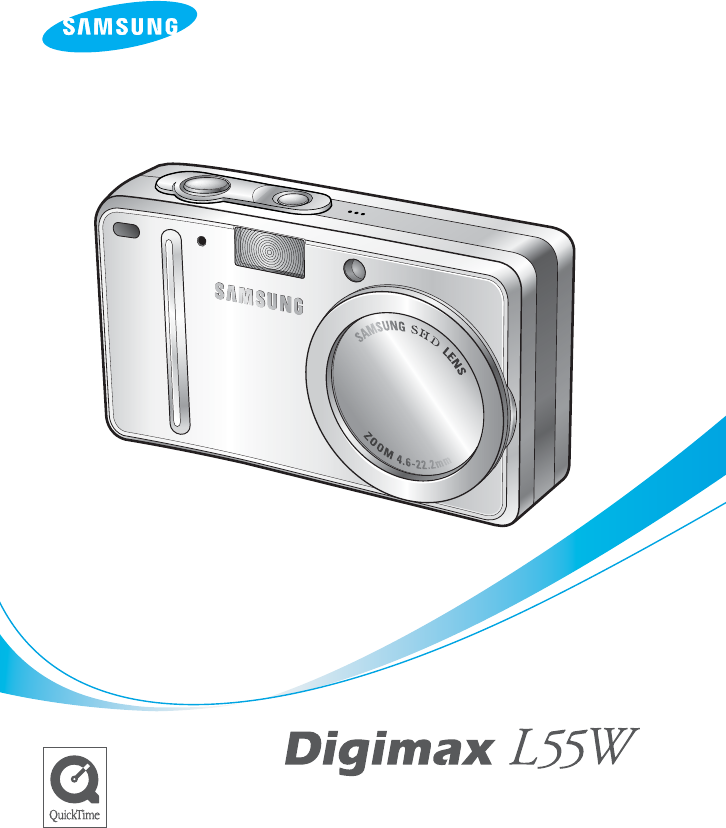
ENGLISH
User’s Manual
Thank you for buying a Samsung Camera.
This manual will guide you through using the camera, including capturing images,
downloading images and using the application software.
Please read this manual carefully before using your new camera.
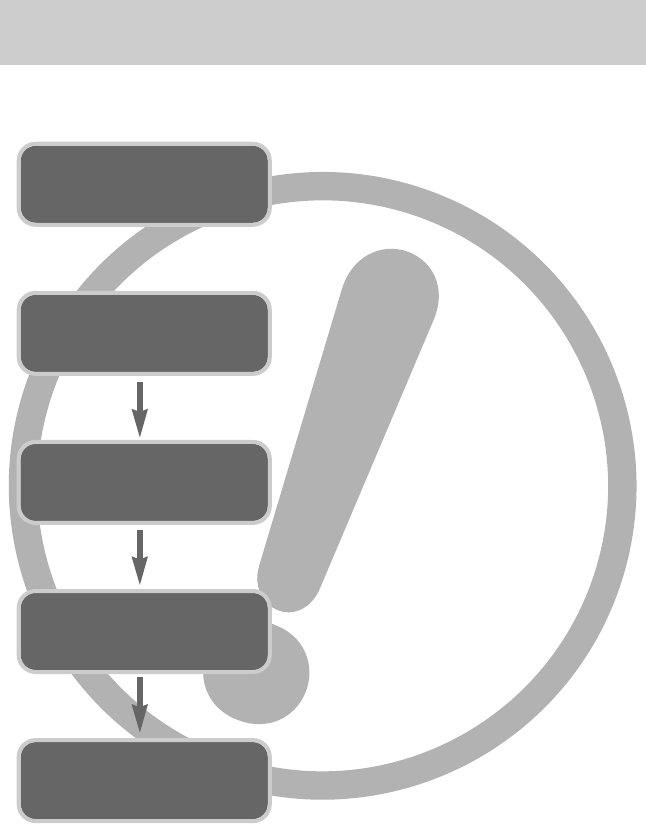
ŝ2Ş
Instructions
ƈUse this camera in the following order
Insert the
USB cable
Set up the
camera driver
Before connecting the camera to a PC, via the USB
cable, you will need to set up the camera driver.
Install the camera driver that is contained in
Application software CD-ROM. (p.118)
Take a picture. (p.26)
Insert the supplied USB cable into the PC’s USB
port and the camera’s USB connection terminal.
(p.127)
Check the camera’s power. If the power is turned off,
press the camera button to turn it on.
Take a picture
Check the
camera’s power
Check
[Removable Disk]
Open WindowŖs EXPLORER and search for
[Removable Disk]. (p.128)
ƃIf you use a card reader to copy the images on the memory card to your PC, the images
could be damaged. When transferring the images taken with the camera to your PC, be sure
to use the supplied USB cable to connect the camera to your PC. Please note that the
manufacturer holds no responsibility for loss or damage of images on the memory card due
to the use of a card reader.

ŝ3Ş
ƃGetting to know your camera 5
ƃDanger 6
ƃWarning 6
ƃCaution 7
ƃSystem chart 8
ƃIdentification of features 10
ƈFront & Top 10
ƈBack & Bottom 10
ƈSide / 5-function button 11
ƈCradle 11
ƈSelf-timer lamp 12
ƈCamera Status Lamp 12
ƈMode icon 12
ƃConnecting to a Power Source 13
ƈUsing the SAC-41 14
ƈHow to charge the rechargeable battery
(SLB-1237) with the SAC-41. 15
ƈUsing the battery 17
ƈRemoving the battery 17
ƃ
Instructions on how to use the memory card
18
ƃInserting the memory card 20
ƃRemoving the memory card 20
ƃ
When Using the Camera for the First Time
21
ƃLCD monitor indicator 22
ƃChanging the recording mode 23
ƈSelecting the [MODE] menu 23
ƈ
If the [STILL & MOVIE] menu was selected
24
ƈIf the [FULL] menu was selected 24
ƈIf the [CUSTOM] menu was selected 25
ƃStarting the recording mode 26
ƈHow to use the Auto mode 26
ƈHow to use the Movie clip mode 26
ƈRecording the movie clip without voice 27
ƈPausing while recording a movie clip
(Successive Recording) 27
ƈHow to use the Program mode 27
ƈHow to use the Scene modes 28
ƈ
How to use the VOICE RECORDING mode
29
ƈ
Pausing while recording a voice recording
29
ƃThings to Watch Out for When Taking
Pictures 30
ƃUsing the camera buttons to adjust the
camera 31
ƈPOWER button 31
ƈSHUTTER button 31
ƈZOOM W / T button 31
ƈ
Voice recording / Voice memo / UP button
34
ƈMacro / Down button 35
ƈFocus lock 36
ƈFlash / Left button 37
ƈSelf-timer / Remote / Right button 39
ƈMENU / OK button 41
ƈM (Mode) button 41
ƈE (Effect) button 44
ƈSpecial Effect : Colour 44
ƈSpecial Effect : Preset focus frames 45
ƈSpecial Effect : Composite shooting 46
ƈSpecial Effect : Photo Frame 48
ƈMovie Clip frame stabiliser 49
ƈ+/- button 50
ƈWide button 54
ƃ
Using the LCD monitor to adjust the camera
settings
55
ƈHow to use the menu 57
ƈMode 57
ƈMode set 58
ƈSize 59
ƈQuality / Frame rate 60
ƈMetering 61
ƈContinuous shot 61
ƈSharpness 62
ƈOSD(On Screen Display) information 62
ƈ
Save / Load a specific camera configuration
(MySET) 63
Contents
READY
RECORDING

ŝ4Ş
ƃStarting play mode 64
ƈPlaying back a still image 64
ƈPlaying back a movie clip 65
ƈHow to capture the movie clip 65
ƈOn camera movie trimming 66
ƈPlaying back a recorded voice 67
ƃLCD monitor indicator 68
ƃUsing the camera buttons to adjust the
camera 69
ƈThumbnail / Enlargement button 70
ƈVoice memo / Up button 70
ƈPlay & Pause / Down button 71
ƈDelete button 72
ƈRed eye / Printer button 73
ƈLeft / Right / Menu / OK button 74
ƈAlbum button 75
ƈRemote control 78
ƃSetting up the play back function using the
LCD monitor 80
ƈRotating an image 83
ƈResize 84
ƈProtecting images 85
ƈDeleting all images 86
ƈDPOF 86
ƈDPOF : STANDARD 87
ƈDPOF : INDEX 87
ƈDPOF : PRINT SIZE 88
ƈDPOF : CANCEL 88
ƈOn Screen Display information 89
ƈCopy To Card 90
ƈPictBridge 91
ƈPictBridge : Picture Selection 92
ƈPictBridge : Print Setting 93
ƈPictBridge : Printing 94
ƈPictBridge : RESET 95
ƃSetup menu 96
ƈFile name 97
ƈAuto power off 98
ƈLanguage 99
ƈFormatting a memory card 99
ƈSetting up the Date / Time / Date type 100
ƈImprinting the recording date 100
ƈAuto Focus lamp 101
ƈSound 101
ƈConnecting an External Device (USB) 102
ƈLCD brightness 102
ƈSelecting Video out type 103
ƈQuick view 105
ƈInitialisation 105
ƃSetting up the Mycam menu 106
ƈStart up image 106
ƈStart up sound 107
ƈShutter sound 107
ƃImportant notes 108
ƃWarning indicator 110
ƃBefore contacting a service centre 111
ƃSpecifications 114
ƃSoftware Notes 116
ƃAbout the software 117
ƃSetting up the application software 118
ƃStarting PC mode 127
ƃ
Removing the USB Driver for Windows 98SE
130
ƃRemovable Disk 132
ƃRemoving the removable disk 133
ƃSetting up the USB Driver for MAC 134
ƃUsing the USB Driver for MAC 134
ƃDigimax Master 135
ƃDigimax Reader 140
ƃFAQ 142
Contents
SOFTWARE
SETUPPLAY
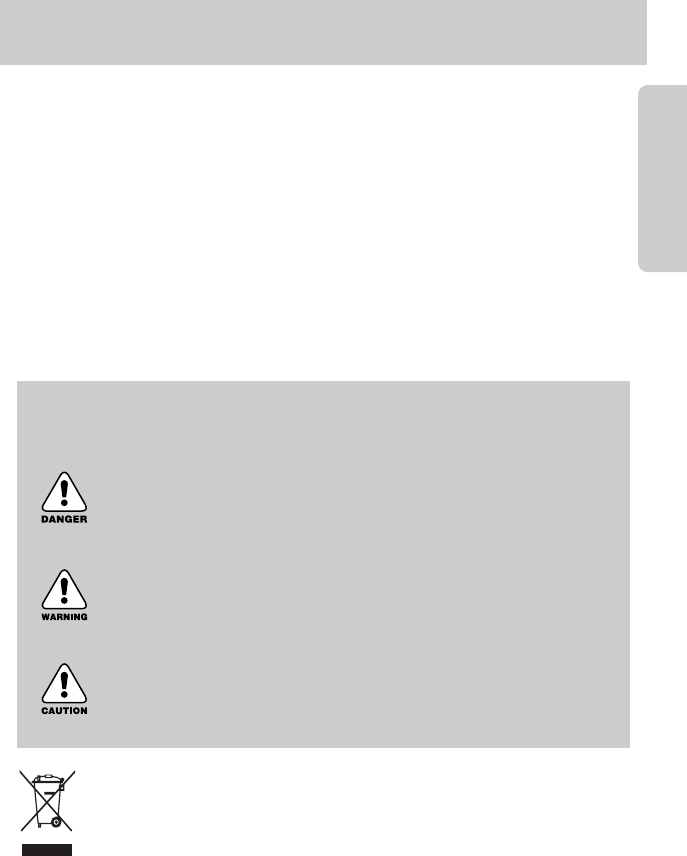
ŝ5Ş
Getting to know your camera
Thank you for buying a Samsung Digital Camera.
ƃPrior to using this camera, please read the user manual thoroughly.
ƃWhen you require After Sales service, please bring the camera and the cause of the camera
malfunction (such as battery, Memory card etc.) to the A/S centre.
ƃPlease check that the camera is operating properly prior to when you intend to use it
(e.g. for a trip or an important event) to avoid disappointment. Samsung camera takes no
responsibility for any loss or damages that may result from camera malfunction.
ƃKeep the manual in a safe place.
ҬMicrosoft, Windows and Windows logo are registered trademarks of Microsoft Corporation
incorporated in the United States and/or other countries.
ҬApple, Mac and QuickTime logo are registered trademarks of Apple computer.
ҬAll brand and product names appearing in this manual are registered trademarks of their
respective companies.
DANGER
DANGER indicates an imminently hazardous situation which, if not avoided, will
result in death or serious injury.
WARNING
WARNING indicates a potentially hazardous situation, which, if not avoided,
could result in death or serious injury.
CAUTION
CAUTION indicates a potentially hazardous situation, which, if not avoided,
may result in a minor or moderate injury.
Correct Disposal of This Product (Waste Electrical & Electronic Equipment)
(Applicable in the European Union and other European countries with separate
collection systems) This marking shown on the product or its literature, indicates that
it should not be disposed with other household wastes at the end of its working life.
To prevent possible harm to the environment or human health from uncontrolled
waste disposal, please separate this from other types of wastes and recycle it responsibly to
promote the sustainable reuse of material resources. Household users should contact either the
retailer where they purchased this product, or their local government office, for details of where
and how they can take this item for environmentally safe recycling. Business users should
contact their supplier and check the terms and conditions of the purchase contract.
This product should not be mixed with other commercial wastes for disposal.
This manual contains instructions on using this camera that will help you to use this
camera safely and correctly. This will help prevent danger and injury to others.

ŝ6Ş
Danger
ƈDo not attempt to modify this camera in any way. This may result in fire, injury, electric shock
or severe damage to you or your camera. Internal inspection, maintenance and repairs
should be carried out by your dealer or Samsung Camera Service centre.
ƈPlease do not use this product in close proximity to flammable or explosive gases, as this
could increase the risk of explosion.
ƈShould any form of liquid or a foreign object enter the camera, do not use it. Switch off the
camera, and then disconnect the power source. You must contact your dealer or Samsung
Camera Service centre. Do not continue to use the camera as this may cause a fire or
electric shock.
ƈDo not insert or drop metallic or inflammable foreign objects into the camera through access
points e.g. the memory card slot and battery chamber. This may cause a fire or electric
shock.
ƈDo not operate this camera with wet hands. This could pose a risk of electric shock.
ƈDo not use the flash in close proximity to people or animals. Positioning the flash too close to
your subject’s eyes, may cause eyesight damage.
ƈFor safety reasons keep this product and accessories out of reach of children or animals to
prevent accidents e.g.:
ҮSwallowing battery or small camera accessories. If an accident should occur, please
consult a doctor immediately.
ҮThere is the possibility of injury from the camera’s moving parts.
ƈbattery and camera may become hot during prolonged use and it may result in camera
malfunction. Should this be the case, allow the camera to sit idle for a few minutes to allow it
time to cool.
ƈDo not leave this camera in places subject to extremely high temperatures, such as a sealed
vehicle, direct sunlight or other places of extreme variances in temperature. Exposure to
extreme temperatures may adversely affect the camera’s internal components and could
cause a fire.
ƈWhen in use, do not cover the camera or AC Charger. This may cause heat to build up and
distort the camera body or cause a fire. Always use the camera and its accessories in a well-
ventilated area.
Warning

ŝ7Ş
Caution
ƈLeaking, overheating, or burst battery could result in fire or injury.
ҮUse battery with the correct specification for the camera.
ҮDo not short circuit, heat or dispose of battery in fire.
ҮDo not insert the battery with the reverse polarities.
ƈRemove the battery when not planning to use the camera for a long period of time.
Battery may leak corrosive electrolyte and permanently damage the camera’s components.
ƈDo not fire the flash while it is in contact with hands or objects. Do not touch the flash after
using it continuously. It may cause burns.
ƈDo not move the camera while it is switched on, if you are using the AC Charger.
After use, always switch off the camera before unplugging the cable from the wall socket.
Then make sure that any connector cords or cables to other devices are disconnected before
moving the camera. Failure to do so may damage the cords or cables and cause a fire or
electric shock.
ƈTake care not to touch the lens and where the lens cover is to avoid taking an unclear image
and possibly causing camera malfunction.
ƈAvoid obstructing the lens or the flash when you capture an image.
An FCC warning
ҮThis device has been tested in accordance with the limits of a class B digital device
under item 15 of the FCC rules. These limits are designed to provide protection
against harmful interference in commercial installation. This equipment generates,
absorbs and can emit radio frequency energy. If it is not installed and used in
accordance with the instructions, it may cause harmful interference to radio
communication. There is however, no guarantee that interference will not occur in
some situations. Should any interference occur when this device is in operation,
please try one or more of the following measures.
ƈChange the location and direction of any aerial.
ƈIncrease distance between the camera and the affected device.
ƈUse a different socket away from the affected device.
ƈPlease contact a Samsung agent or a radio/TV engineer.
ҮThis device complies with part 15 of the FCC Rules.
ҮChanges or modifications not expressly approved by the party responsible for
compliance could void the users authority to operate the equipment.
NOTE: This equipment has been tested and found to comply with the limits
for a Class B digital device, pursuant to part 15 of the FCC Rules. These
limits are designed to provide reasonable protection against harmful
interference in a residential installation.
This equipment generates, uses and can radiate radio frequency energy and,
if not installed and used in accordance with the instructions, may cause
harmful interference to radio communications. However, there is no
guarantee that interference will not occur in a particular installation. If this
equipment does cause harmful interference to radio or television reception,
which can be determined by turning the equipment off and on, the user is
encouraged to try to correct the interference by one or more of the
following measures:
- Reorient or relocate the receiving antenna.
- Increase the separation between the equipment and receiver.
- Connect the equipment into an outlet on a circuit different from that to
which the receiver
is connected.
- Consult the dealer or an experienced radio/TV technician for help.
CAUTION : Changes or modifications not expressly approved by the party
responsible for compliance could void the user’s authority to operate the
equipment.
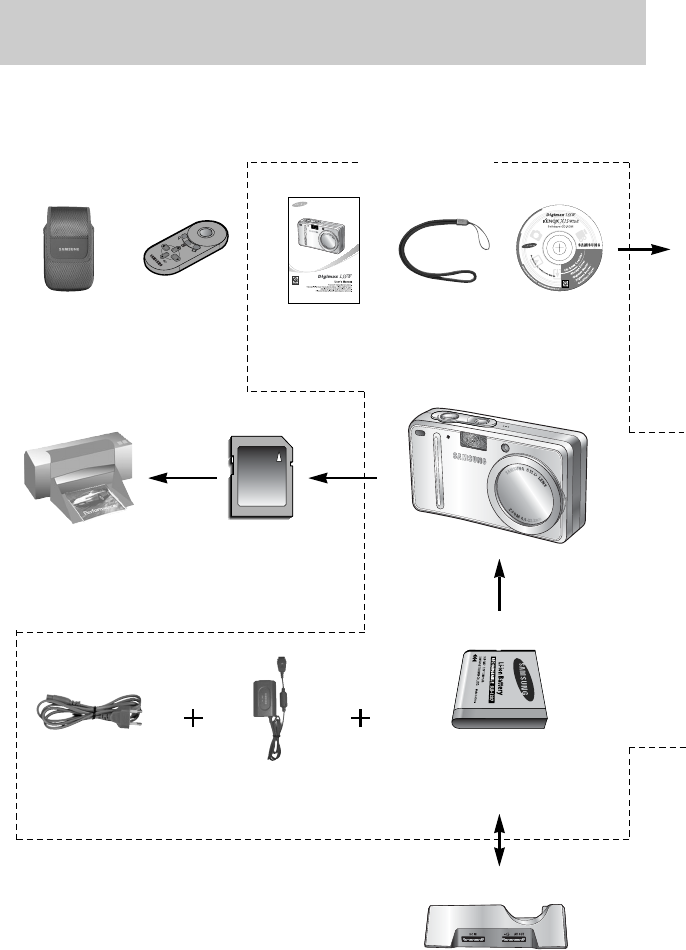
ŝ8Ş
System chart
Please check that you have the correct contents before using this product. The contents can
vary depending on the sales region. To buy the optional equipment, contact your nearest
Samsung dealer or Samsung service centre.
Software CD
(see p.117)
Camera strap
User manual,
Product warranty
Camera case
SD memory card/MMC
(see p.18)
DPOF compatible
printer (see p.86)
Rechargeable
battery (SLB-1237)
Cradle
SAC-41AC cord
< Included items >
Remote control
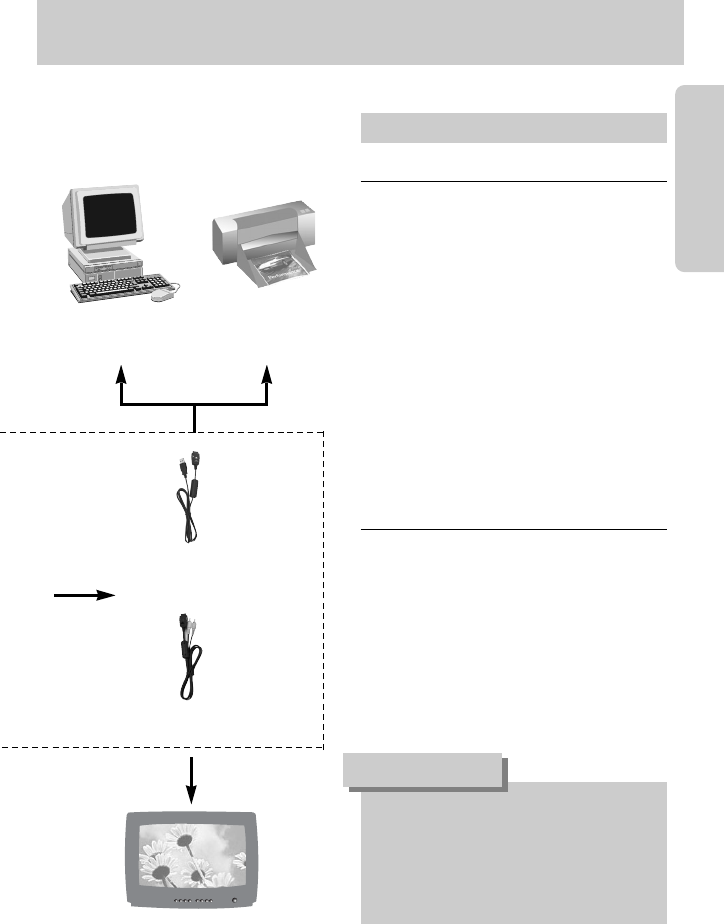
ŝ9Ş
System chart
USB cable
PictBridge compatible
printer(see p.91)
Computer
(see p.127)
For Windows
ҮWindows 98/ 98SE/ 2000/ ME/ XP
ҮPC with processor better than Pentium II
450MHz (Pentium 700MHz or better is
recommended)
Ү200MB of available hard-disk space
(Over 1GB is recommended)
ҮMinimum 64MB RAM (XP : 128MB)
Ү1024x768 pixels, 16-bit colour display
compatible monitor (24-bit colour display
recommended)
ҮDirectX 9.0 or later
ҮUSB port
ҮCD-ROM drive
For Macintosh
ҮPower Mac G3 or later
ҮMac OS 10.0 or later
ҮMinimum 64MB RAM
Ү110MB of available hard-disk space
ҮUSB port
ҮCD-ROM drive
ҮQuickTime Player
System Requirements
When you connect the camera to a
computer, printer or external monitor, you
have to use the USB/ AV cable supplied
with the camera, or the external devices
can't recognise the camera.
CAUTION
External monitor
Yellow colour - Video
White colour - Voice
(see p.103)
AV cable
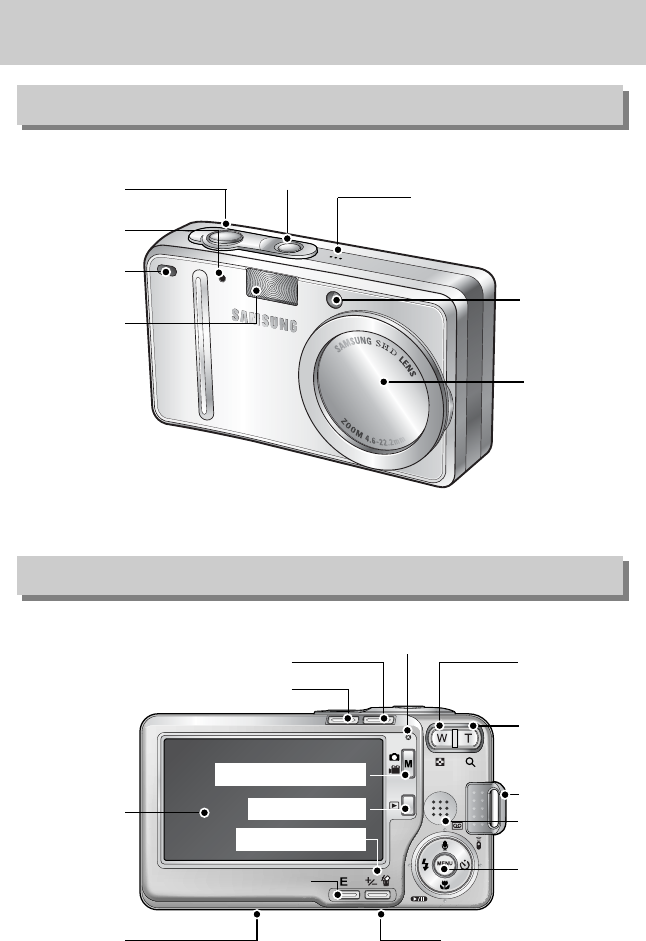
ŝ10Ş
Identification of features
Front & Top
Back & Bottom
Flash
Self-timer lamp
Remote control
sensor
Shutter button Power button Microphone
Auto Focus lamp
Lens / Lens cover
LCD monitor
Tripod
DC/USB/AV connection terminal
Cradle connector
5 function button
E (Effect) button
Speaker
Strap eyelet
Zoom T button
(Digital zoom)
Camera status lamp
Zoom W button
(Thumbnail)
Wide button
Red-eye button / Printer button
M(Mode/Album) button
Play mode button
+/-, Delete button
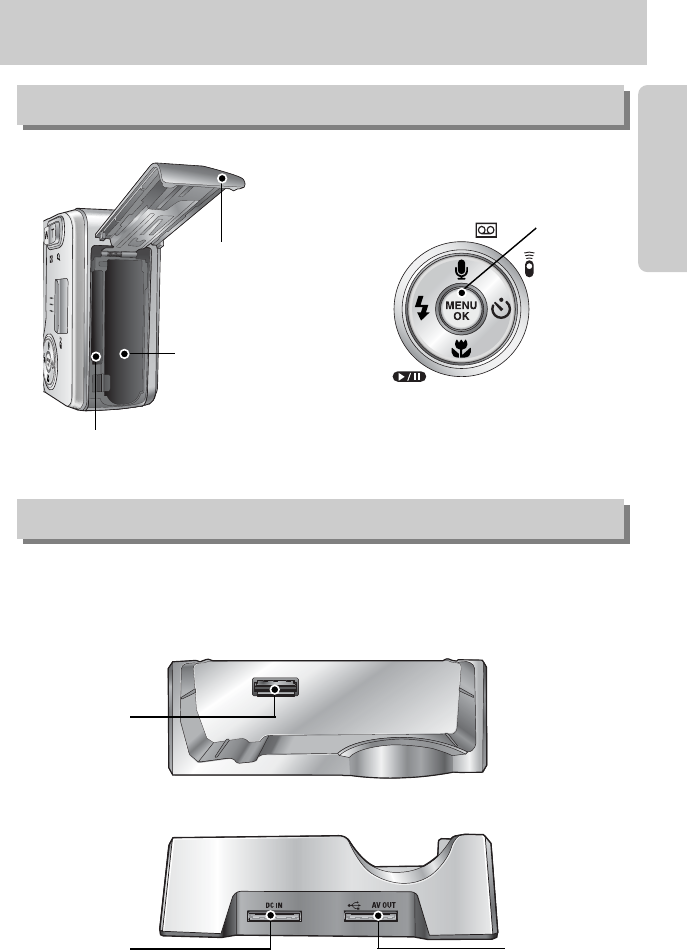
ŝ11Ş
Identification of features
Side/ 5-function button
ƃBack
ƃTop
ƈYou can recharge your rechargeable battery, transfer a captured image to print, and
download images with the cradle. (Refer to page 14, 91~95, 125~127)
Battery chamber
Cradle
Camera
connection
terminal
USB port
AV connection
terminal
DC connection
terminal
Memory card slot
Battery chamber
cover
Voice memo / Voice Recording / Up button
Flash / Left
button
Menu /
OK button
Self-timer /
Remote /
Right button
Macro / Down button
Play & Pause button
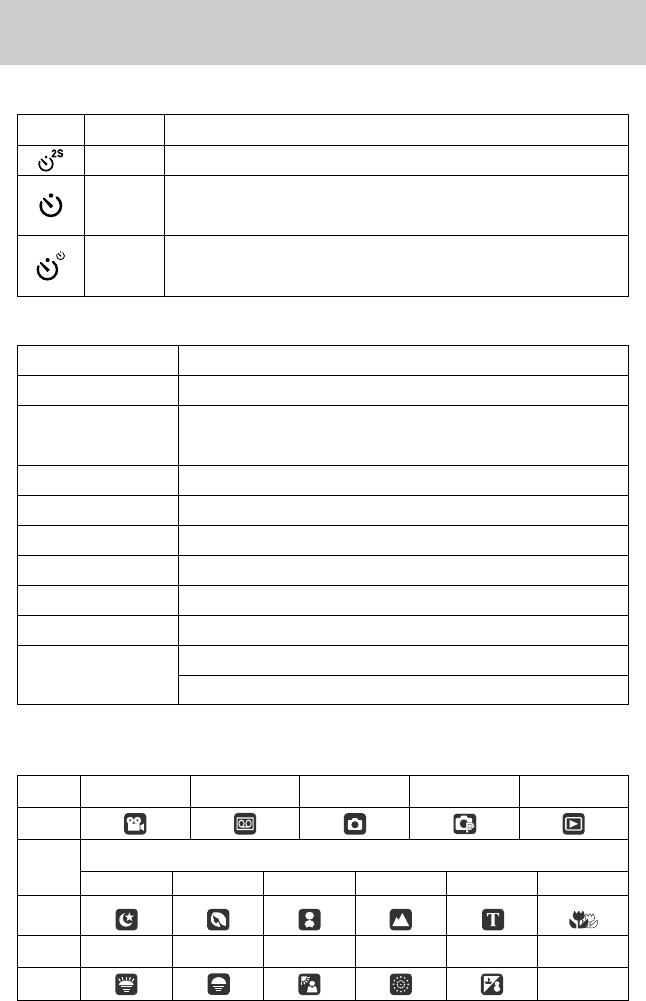
ŝ12Ş
Identification of features
ƈMode icon : Refer to page 23~25 for more information about the camera mode setting.
ƈSelf-timer lamp
ƈCamera Status Lamp
Status Description
Power on The lamp turns on and off when the camera is ready to take a picture
The lamp blinks while saving the image data and turns off when the
camera is ready to take a picture
While voice memo recording
The lamp blinks at 1 second intervals
While voice recording The lamp blinks at 1 second intervals
When the USB cable is inserted to a PC
The lamp lights up (LCD monitor turns off after initializing the device)
Transmitting Data with a PC
The lamp blinks (LCD monitor turns off)
When the USB cable is inserted to a printer
The lamp is off
When the printer is printing
The lamp blinks
The lamp turns on (The camera focus on the subject)
The lamp blinks (The camera doesn't focus on the subject)
Icon Status Description
Blinking For the 2 seconds, the lamp blinks quickly at 0.25-second intervals.
For the first 8 seconds, the lamp blinks at 1 second intervals.
For the final 2 seconds, the lamp blinks quickly at 0.25-second intervals.
A picture will be taken after about 10 seconds and 2 seconds later a
second picture will be taken.
Blinking
After taking a picture
When the AF activates
Blinking
MODE MOVIE
VOICE RECORDING
AUTO PROGRAM PLAY
Icon
NIGHT PORTRAIT CHILDREN
LANDSCAPE
TEXT CLOSE UP
Icon
MODE DAWN SUNSET BACKLIGHT
FIREWORKS
BEACH & SNOW
-
Icon -
MODE SCENE
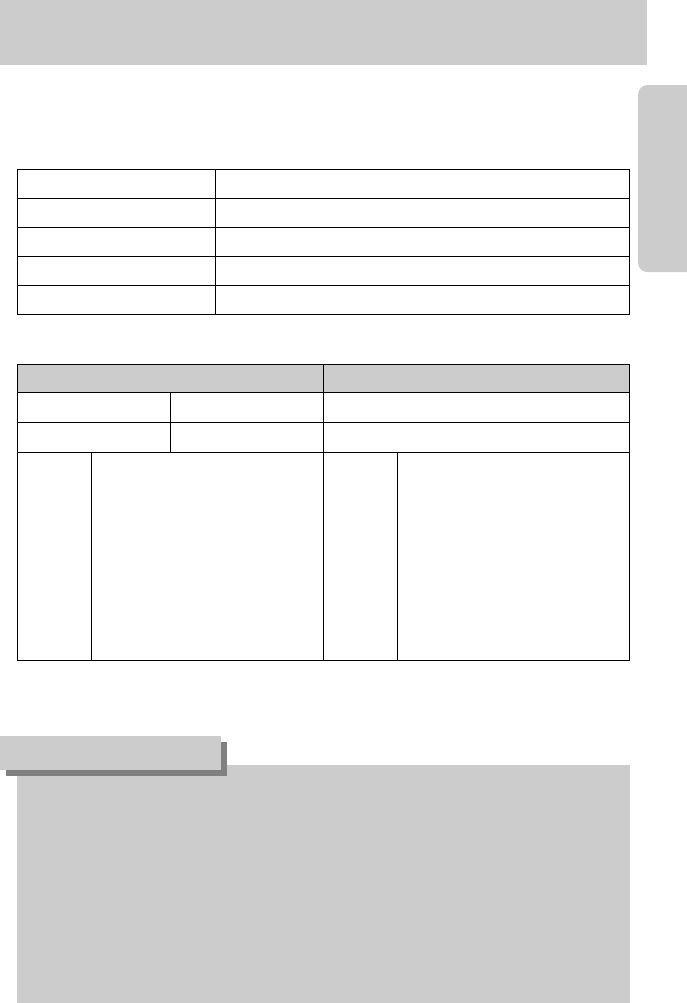
ŝ13Ş
Connecting to a Power Source
Still image Movie
Battery life Number of images Recording time
Approx. 180 MIN Approx. 340 Approx.90 MIN
Important information about battery usage
ƃWhen the camera is not used, turn off the camera power.
ƃPlease remove the battery if the camera will not be used for long periods.
Battery can lose power over time and are prone to leaking if kept inside the camera.
ƃLow temperatures (below 0˚C) can affect the performance of the battery and you may
experience reduced battery life.
ƃBattery will usually recover at normal temperatures.
ƃDuring extended use of the camera, the camera body may become warm.
This is perfectly normal.
INFORMATION
ƈYou should use the rechargeable battery (SLB-1237) supplied with the camera.
Be sure to charge the battery before using the camera.
ƈSLB-1237 rechargeable battery Specification
ƈNumber of images and battery life
ſThese figures are measured under Samsung’s standard conditions and Shooting conditions
and may vary depending on the way of user’s usage.
Using the fully charged battery
Auto mode, 5M image size
Fine image quality,
Shot to shot interval : 30Sec.
Changing the zoom position
between the Wide and the Tele
ends every 1 shot.
Using the flash every two times.
Based on
the
following
shooting
conditions
Based on
the
following
shooting
conditions
Using the fully charged battery
640X480 image size
30fps frame rate
Model SLB-1237
Type Lithium Ion
Capacity 1280mAh
Voltage 3.7V
Charging time Approx. 170 MIN (Using the SAC-41)
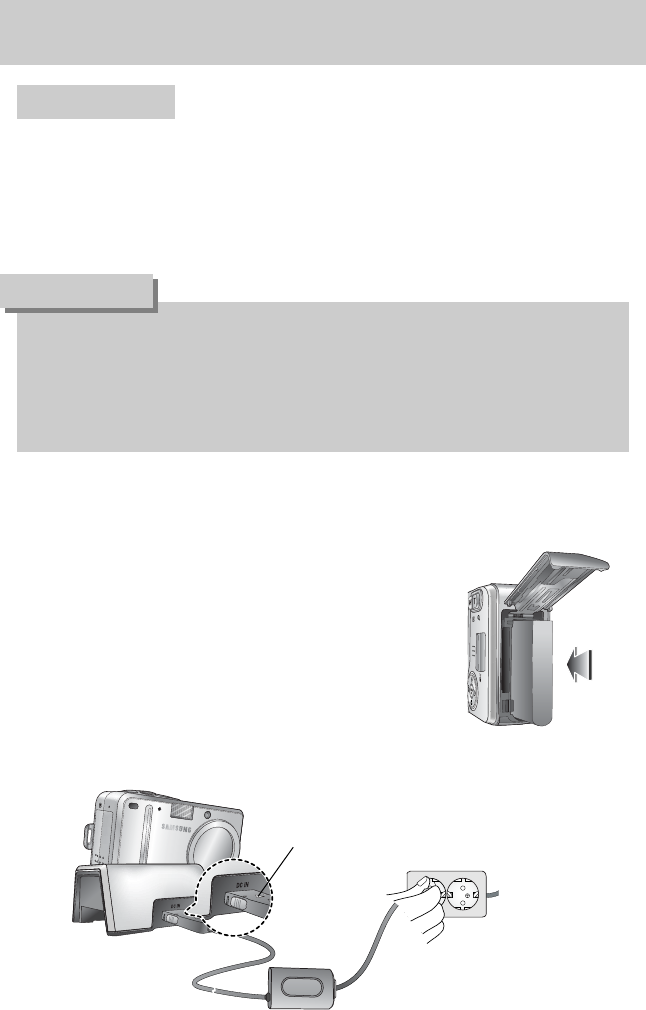
ŝ14Ş
Connecting to a Power Source
ƃAlways turn off the power before taking the SAC-41 out of the mains supply.
ƃAs with all mains powered devices, safety is important. Ensure that neither the camera
nor Charger comes into contact with water or metallic materials.
ƃPlease ensure that you use the SAC-41 with the correct specification for the camera.
Failure to do so may affect your warranty.
DANGER
If you have access to a mains supply, using an SAC-41 allows the camera to be used for long
periods of time.
Plug the SAC-41 into the DC connection terminal on the camera or cradle.
Before turning on the camera power with an SAC-41, insert the rechargeable battery that was
charged for over 10 minutes with turning off the camera.
ƃCharging with the cradle
1. Insert the rechargeable battery into the battery
chamber.
ƈHow to charge the rechargeable battery (SLB-1237) with the SAC-41.
Using the SAC-41
Charging LED
2. Place the camera correctly in the cradle. 3. Put the SAC-41 into your power socket
and DC connection terminal of the cradle.
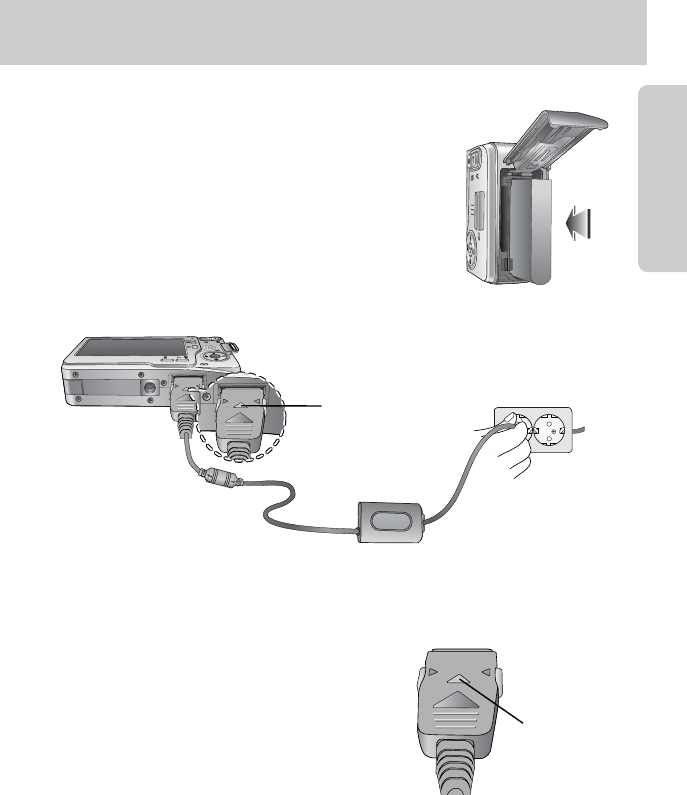
ŝ15Ş
Connecting to a Power Source
ſIf you connect the SAC-41 to camera without inserting the rechargeable battery, the charging
LED will brink or be off. In this case, insert the battery and connect the SAC-41 again.
ƈImportant information about battery (SLB-1237) charging with the SAC-41
ƃIf the charging LED of the SAC-41 does not turn on or
blink after inserting the rechargeable battery, please
check whether the battery are inserted correctly.
ƃPlease check the battery charging status with the
charging LED of SAC-41. Charging LED
Charging LED
ƃCharging with the camera
1. Insert the rechargeable battery into the battery
chamber.
2. Put the SAC-41 into your power socket and DC
connection terminal of the camera.
ƈHow to charge the rechargeable battery (SLB-1237) with the SAC-41.
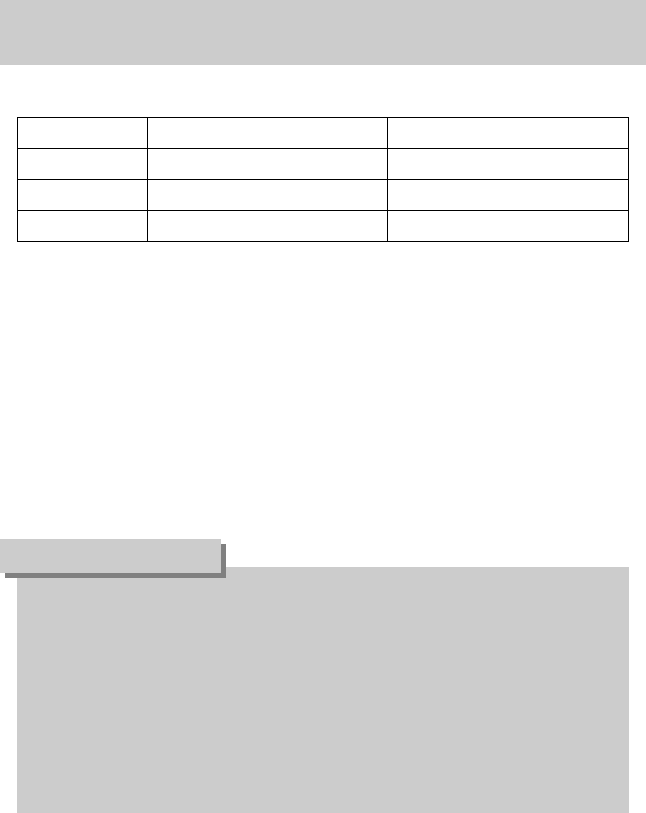
ŝ16Ş
Important information about the rechargeable battery.
ƃIf you charge the battery with the camera power on, the battery can't charge fully.
To charge the battery fully, turn the camera off when you charge it.
ƃIf you insert the fully discharged battery to charge it, do not turn on the camera at the
same time. The camera may not be turned on because of the low battery capacity.
Charge the battery for over 10 minutes to use the camera.
ƃDo not use the flash frequently or take a movie clip with the fully discharged battery
charged for a short time. Even if the charger is inserted, the camera power may be turned
off because the rechargeable battery is discharged again.
INFORMATION
Connecting to a Power Source
ƈCharging LED of the SAC-41
Status Using the cradle Direct to the camera
Being Charged Red LED is on Red LED is on
Charging is complete
Green LED is on Green LED is on
Charging error Red LED is off or blinking Red LED is off or blinking
ƃIf there is a charging error, please check all the power connections are in place.
ƃA USB cable for transmitting data can’t be used for charging the rechargeable battery.
ƈCharging time (When the camera is turned off)
- Using the cradle : About 150MIN
- Using the SAC-41 : About 150MIN
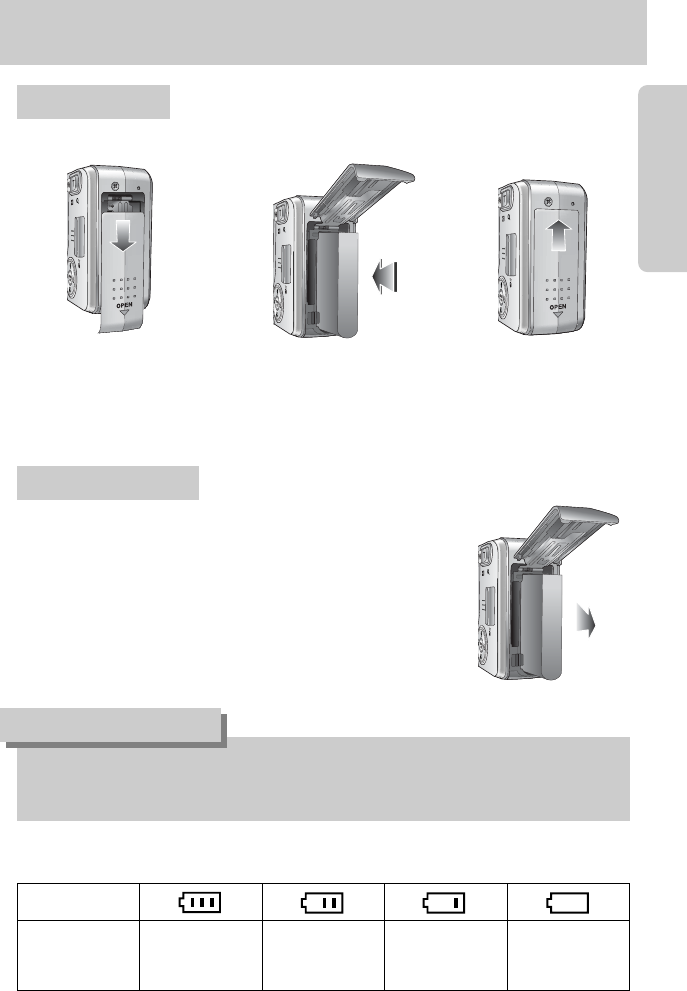
ŝ17Ş
Connecting to a Power Source
Using the battery : If the camera does not turn on after you have inserted battery, please
check whether the battery are inserted with the correct polarity(+/-).
2. Insert the battery taking
note of the polarity
(+ / -).
3. To close the battery
chamber cover, push it
until it clicks.
Removing the battery
1. Turn off the camera power.
Open the battery chamber cover and move the battery
holder aside. The battery will be released.
2. Take out the battery and close the battery chamber
cover.
1. Open the battery chamber
cover by pushing in the
direction of the arrow.
ƃWhen the battery chamber cover is opened, do not press the battery chamber cover by
force. This may cause the battery chamber cover modification or breakage.
INFORMATION
Battery status
Battery indicator
The battery is fully
charged
Low battery capacity
(Prepare to recharge or
use spare battery)
Low battery capacity
(Prepare to recharge or
use spare battery)
Low battery capacity
(Prepare to recharge or
use spare battery)
ƈThere are 4 indicators for battery condition that are displayed on the LCD monitor.

Instructions on how to use the memory card
ƃBe sure to format the memory card (see p.99) if you are using a newly purchased memory for
the first time, if it contains data that the camera cannot recognise, or if it contains images
captured with a different camera.
ƃTurn off the camera power whenever the memory card is being inserted or removed.
ƃRepeated use of the memory card will eventually reduce the memory card’s performance.
Should this be the case, you will need to purchase a new memory card.
Wear and tear on the memory card is not covered by the Samsung warranty.
ƃThe memory card is an electronic precision device.
Do not bend, drop or subject the memory card to any heavy impact.
ƃDo not store the memory card in an environment with strong electronic or magnetic fields,
e.g. near loud speakers or TV receivers.
ƃPlease do not use or store in an environment where there are extremes in temperature.
ƃDo not allow the memory card to become dirty or to come into contact with any liquid.
Should this happen, clean the memory card with a soft cloth.
ƃPlease keep the memory card in its case when not in use.
ƃDuring and after periods of extended use, you may notice that the memory card is warm.
This is perfectly normal.
ƃDo not use a memory card that is used in another digital camera.
To use the memory card in this camera, format the memory card using this camera.
ƃDo not use a memory card formatted by another digital camera or memory card reader.
ƃIf the memory card is subjected to any of the following, the recorded data may become
corrupted :
- When the memory card is used incorrectly.
- If the power is switched off or the memory card is removed while recording, deleting
(formatting) or reading.
ƃSamsung cannot be held responsible for lost data.
ƃIt is advisable to copy important data onto other media as back-up e.g. floppy disks, hard
disks, CD etc.
ƃIf there is insufficient memory available
: A [CARD FULL! / MEMORY FULL!] message will appear and the camera will not operate.
To optimise the amount of memory in the camera, replace the memory card or delete
unnecessary images stored on the memory.
ŝ18Ş
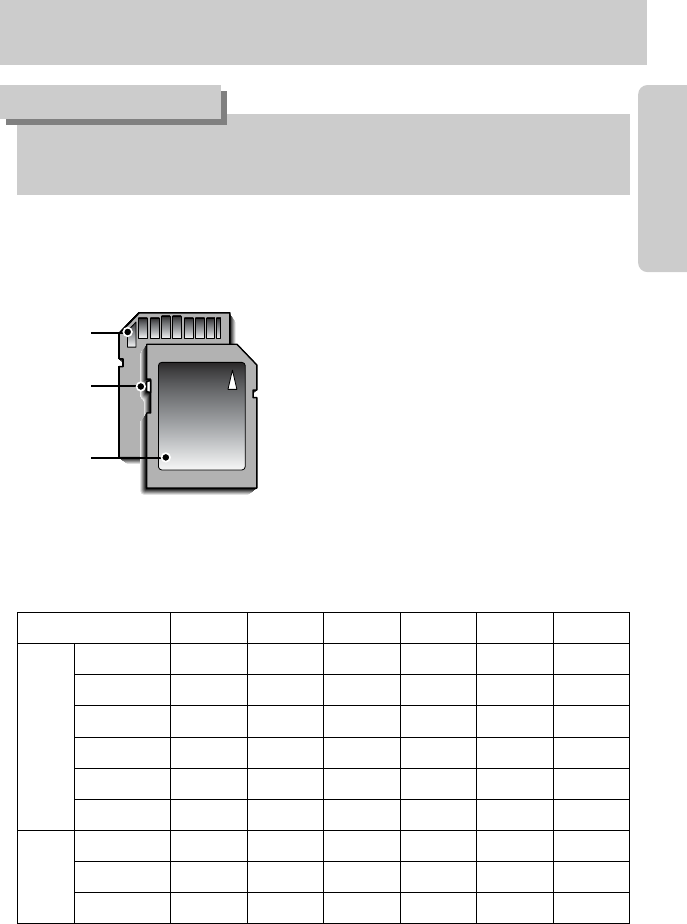
ŝ19Ş
Instructions on how to use the memory card
ƃDon't remove the memory card when the camera status lamp is blinking as this may
cause damage to data in the memory card.
INFORMATION
[ SD (Secure Digital) memory card ]
Write
protect
switch
Label
Card pins
ƈThe camera can use SD Memory Cards and MMC (Multi Media Cards).
Please consult the enclosed manual for using the MMC Cards.
The SD memory card has a write protect switch
that prevents image files from being deleted or
formatted. By sliding the switch to the bottom of
the SD memory card, the data will be protected.
By sliding the switch to the top of the SD memory
card, the data protection will be cancelled.
Slide the switch to the top of the SD memory card
before taking a picture.
ƈWhen using a 24MB internal memory, the specified shooting capacity will be as follows.
These figures are approximate as image capacities can be affected by variables such as
subject matter and memory card type.
ſFigures in the ( ) are shooting capacity taken in the Wide angle mode.
ſThe recording times can be changed by the zoom operation.
The zoom button doesn’t use during the movie recording.
Recorded image size TIFF S. FINE FINE NORMAL 30FPS 15FPS
5M 1(1) 9(9) 18(19) 27(27) - -
4M 2(1) 12(11) 23(22) 34(33) - -
3M 2(2) 14(15) 28(29) 41(43) - -
2M 4(4) 23(25) 45(46) 64(67) - -
1M 10(8) 47(41) 74(64) 106(99) - -
VGA 24(22) 99(92) 148(135) 185(185) - -
640 - - - -
)JW]\ 1min 26sec )JW]\ 2min 06sec
320 - - - -
)JW]\ 3min 25sec )JW]\ 4min 38sec
160 - - - -
)JW]\ 6min 04sec )JW]\ 7min 10sec
Still
image
* Movie
clip
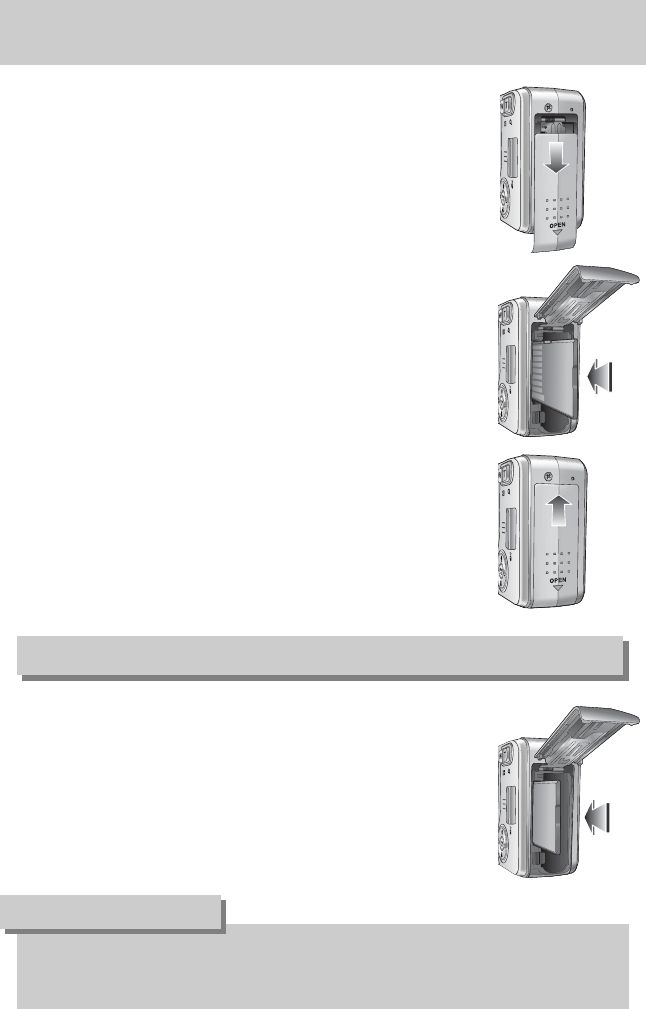
ŝ20Ş
Inserting the memory card
3. To close, push the battery chamber cover until you hear a
click. If the memory card does not slide in smoothly, do
not attempt to insert it by force. Check the direction of
insertion, and then insert it correctly. Do not insert the
memory card the wrong way round. Doing so may
damage the memory card slot.
2. Have the front of the memory card facing toward the front
of the camera (lens) and the card pins toward the back of
the camera (LCD monitor), and then push the memory
card into the card slot until you hear a click.
1. Turn off the camera’s power and pull the battery chamber
cover in the direction of the arrow to open.
1. Turn the power off using the power button.
Open the battery chamber cover and press the memory
card as shown in the image and release.
2. Remove the memory card and close the battery chamber
cover.
Removing the memory card
ƃWhen the camera is turned on, inserting or removing the memory card turns the camera
power off.
INFORMATION
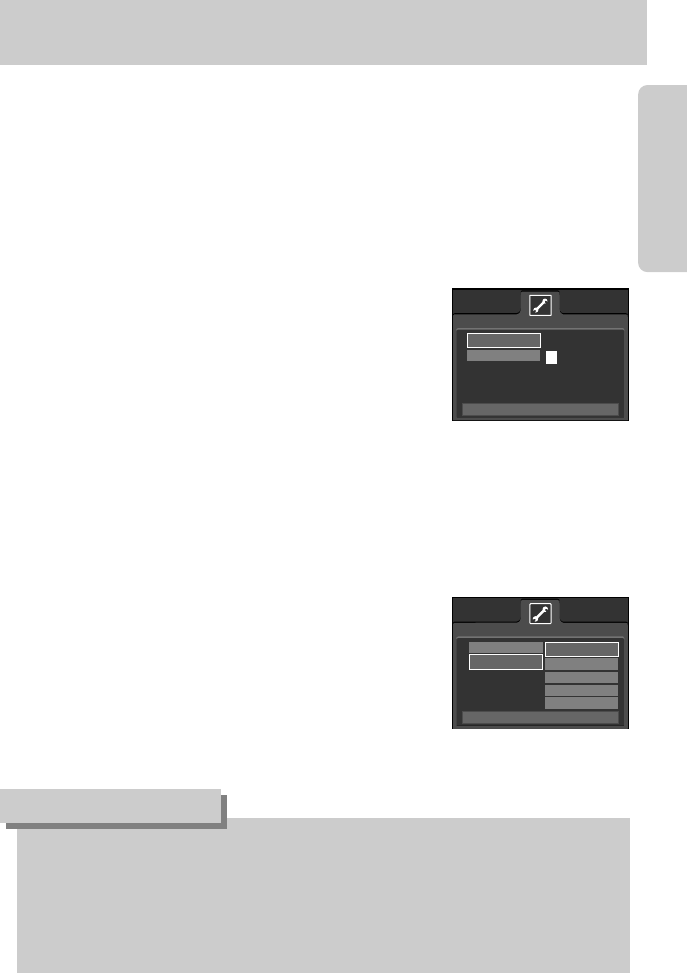
ŝ21Ş
When Using the Camera for the First Time
ƈCharge the rechargeable battery fully before using the camera for the first time.
ƈWhen the camera is turned on for the first time, a menu will be displayed to set date, time and
language in the LCD monitor. This menu will not be displayed after setting up the date, time
and language. Set up the date, time and language before using this camera.
ƃSetting up the date, time and date type
1. Select the [DATE&TIME] menu by pressing the
UP/DOWN button and press the RIGHT button.
2. Select the desired sub menu by pressing the UP/ DOWN/
LEFT/ RIGHT button and press the OK button.
RIGHT button : selects YEAR/ MONTH/ DAY/ HOUR/
MINUTE/ DATE TYPE
LEFT button : Moves the cursor to the [DATE&TIME]
main menu if the cursor is at the first
item of the date and time setup. In all other instances, the cursor will be
shifted to the left of its current position.
UP/ DOWN button : changes the value of each item.
ƃYou can select 21 languages. These are listed below :
English, Korean, French, German, Spanish, Italian, S.Chinese, T.Chinese, Japanese,
Russian, Portuguese, Dutch, Danish, Swedish, Finnish, Thai,
BAHASA(MALAY/ INDONESIAN), Arabic, Hungarian, Czech and Polish.
ƃEven if the camera is restarted, the language setting will be maintained.
INFORMATION
ƃSetting up the language
1. Select the [LANGUAGE] menu by pressing the
UP/DOWN button and press the RIGHT button.
2. Select the desired sub menu by pressing the UP/ DOWN
button and press the OK button.
When the settings are complete, press the MENU button
twice to exit the menu screen.
DATE&TIME
LANGUAGE
SETUP
BACK:ȜSET:OK
Ɗ
"
ƌ
AAAA55,,
DATE&TIME
LANGUAGE ENGLISH
ጥૹ
FRANÇAIS
DEUTSCH
ESPAÑOL
SETUP
BACK:ȜSET:OK
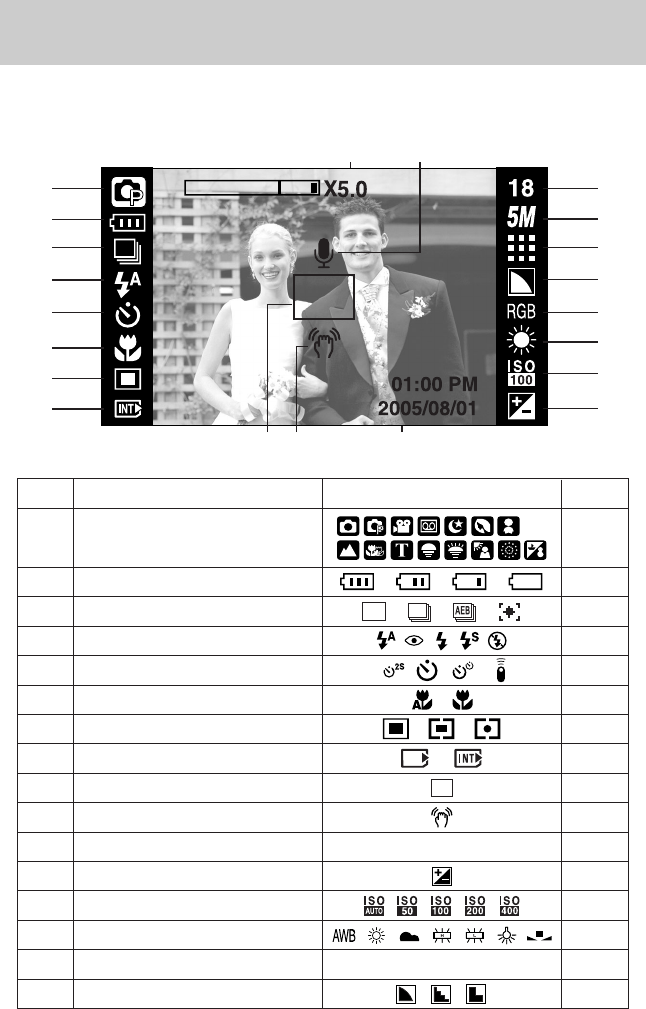
ŝ22Ş
LCD monitor indicator
ƈThe LCD monitor displays information about the shooting functions and selections.
ƈYou can see the wider angle of subject by using the Wide button (p.54). The illustrations of
this manual are based on the normal angle mode.
[Image & Full Status]
No. Description Icons Page
2Battery p.17
3Continuous shot/ Stabiliser p.61
4Flash p.37
5Self-timer p.39
6Macro p.35
7Metering p.61
8Card inserted indicator -
9Auto focus frame -
10 Camera shake warning p.30
11 Date/ Time 2005/08/01 01:00 PM p.100
12 Exposure compensation p.52
13 ISO p.51
14 White Balance p.51
15 RGB RGB p.50
16 Sharpness p.62
Recording mode
1p.58
ڹ
ں
ڻ
ڼ
ڽ
ھ
ڿ
ۀ
ۅ
ۄ
ۆ
ۇ
؆
؇
؈
ۂہ ۃ
؊؉
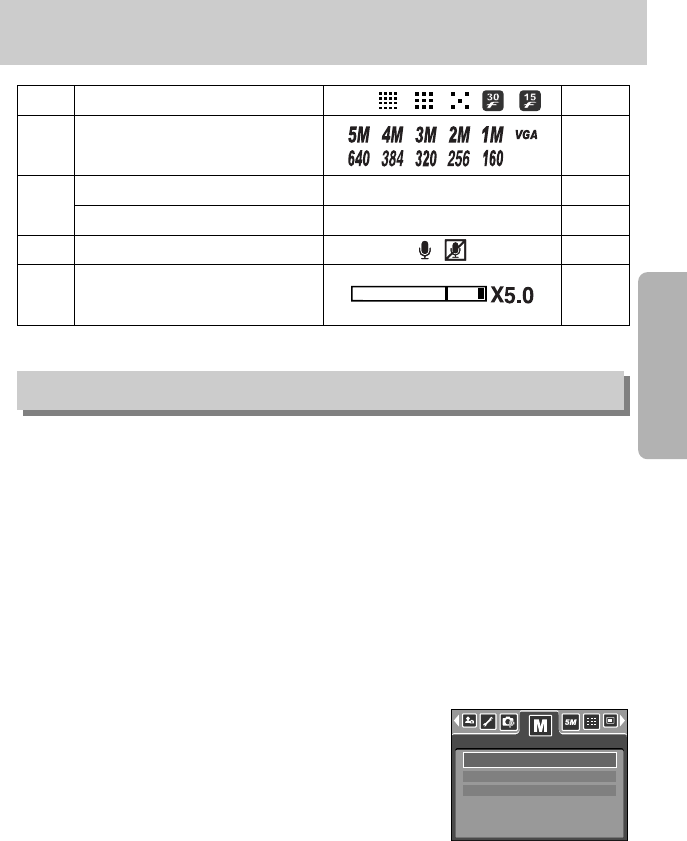
ŝ23Ş
LCD monitor indicator
Changing the recording mode
ƈYou can select the desired working mode by the M (mode) button located on the back of the
camera and [MODE], [MODE SET] menu. Auto, Program, Movie clip, Scene (Night, Portrait,
Children, Landscape, Text, Close-up, Dawn, Sunset, Backlight, Fireworks, Beach & Snow)
camera modes are available.
MODE
17 Image quality / Frame rate p.60
Number of available shots remaining 15 p.19
Remaining time (Movie clip/ Voice recording)
00:01:30/ 01:00:00 p.19
20 Voice memo/ Mic. off p.29/27
19
18 p.59
Image size
Optical/ Digital Zoom bar/
Digital Zoom rate
21 p.32
ƃSelecting the [MODE] menu
1. Insert the battery (p.17).
2. Insert the memory card (p.20). As this camera has a 24MB internal memory, you do not
need to insert the memory card. If the memory card is not inserted, an image will be stored
in the internal memory. If the memory card is inserted, an image will be stored on the
memory card.
3. Close the battery chamber cover.
4. Press the power button to turn on the camera.
5. Press the menu button and a menu will display.
6. Use the Left/ Right button to select the [MODE] menu.
7. Select [STILL & MOVIE], [FULL] or [CUSTOM] sub menu
by pressing the UP/ DOWN button.
- [STILL & MOVIE] : A still image mode that was selected
on the [MODE SET] menu and movie
clip mode can be selected.
Refer to page 58 for more information about using the [MODE SET] menu.
- [FULL] : Auto, Program, Movie clip and Scene modes can be selected.
- [CUSTOM] : Modes set as on in the [MODE SET] menu can be selected.
8. Press the MENU button and the menu will disappear.
STILL & MOVIE
FULL
CUSTOM
TIFF
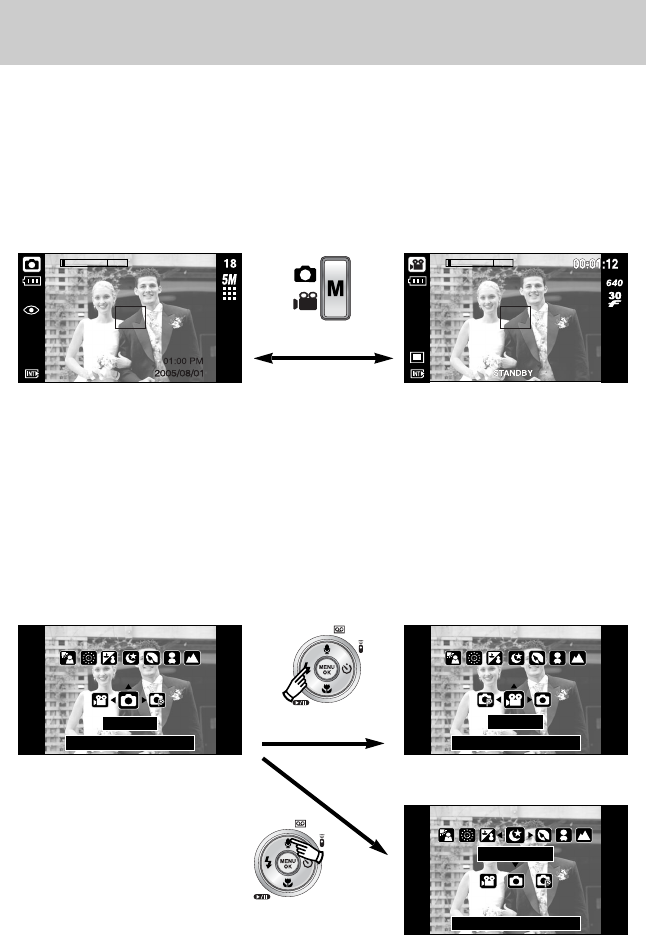
ŝ24Ş
ƃChanging the recording mode : If the [STILL & MOVIE] menu was selected
Steps from 1-4 are the same as those for selecting the [MODE] menu.
5. The recording mode used just before will display.
6. Press the M (Mode) button located on the back of the camera and the recording mode will
change to the movie clip mode.
7. Press the M (Mode) button again and a still image mode selected on the [MODE SET]
menu will be selected.
ƃChanging the recording mode : If the [FULL] menu was selected
Steps from 1-4 are the same as those for selecting the [MODE] menu.
5. The recording mode used just before will display.
6. Press the M (Mode) button located on the back of the camera and the mode selection
menu will display.
7. To select the Auto, Program, Movie clip or Scene modes, press the Left/ Right button.
To move between the Auto, Manual, Movie clip menu line and Scene menu line, press the
Up/ Down button.
8. Press the M (Mode) button and the mode selection menu will disappear.
Pressing the M (Mode) button
[AUTO mode] [MOVIE CLIP mode]
Pressing the Up button
[Selecting the Scene mode]
Pressing the Left button
[Mode selection menu]
AUTO MOVIE
[Selecting the Movie clip mode]
SET:OK SET:OK
SET:OK
NIGHT
Changing the recording mode
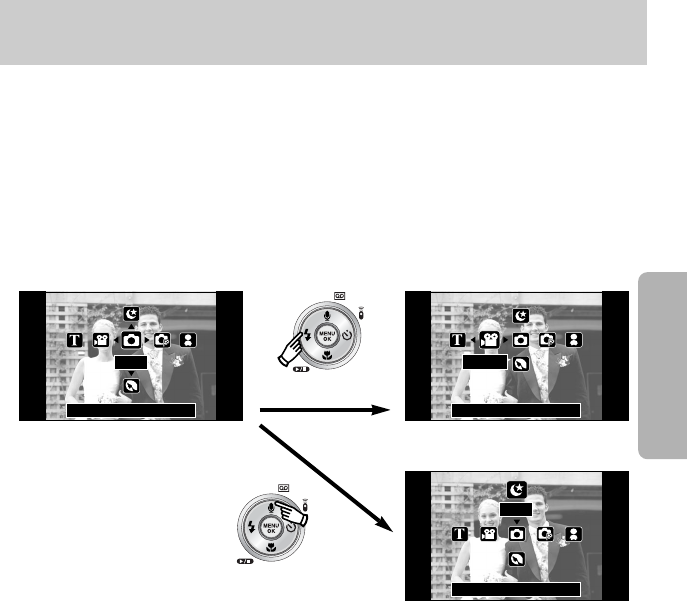
ŝ25Ş
ƃChanging the recording mode : If the [CUSTOM] menu was selected
Steps from 1-4 are the same as those for selecting the [MODE] menu.
5. The recording mode used just before will display.
6. Press the M (Mode) button located on the back of the camera and the mode selection
menu will display.
7. You can select modes set as on in the [MODE SET] menu by pressing the Up/ Down/ Left/
Right buttons. Refer to page 58 for more information about using the [MODE SET] menu.
8. Press the M (Mode) button and the mode selection menu will disappear.
Pressing the Up button
NIGHT
[Selecting the Scene mode]
Pressing the Left button
[Mode selection menu]
AUTO
SET:OK
MOVIE
[Selecting the Movie clip mode]
SET:OK
SET:OK
Changing the recording mode
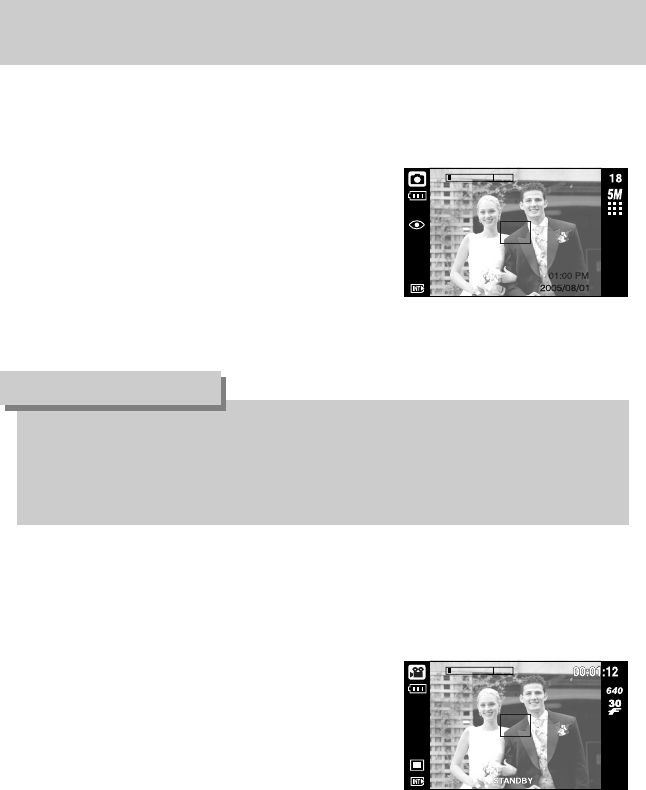
ŝ26Ş
ƈHow to use the Movie clip mode
A movie clip can be recorded for as long as the available recording time of the memory
capacity allows.
1. Select the [FULL] sub menu on the [MODE] menu
(p.23).
2. Select the Movie clip mode by pressing the M
(Mode) button (p.24).
3. Point the camera towards the subject and compose
the image by using the LCD monitor.
4. Press the shutter button once and movie clips are
recorded for as long as the available recording time
allows. Movie clips will still be recorded if the shutter
button is released.
If you wish to stop recording, press the shutter button again.
ſImage size and type are listed below.
- Image size : Normal angle mode - 640X480, 320X240, 160X120 (user selectable)
Wide angle mode - 640X360, 384X216, 256X144 (user selectable)
- Movie clip file type : MP4 (MPEG-4)
ƃIf the auto focus frame turns to red when you press the shutter button down half way, it
means that the camera cannot focus on the subject. Should this be the case, the camera
is less likely to capture an image clearly.
ƃAvoid obstructing the lens or the flash when you capture an image.
INFORMATION
[AUTO mode]
[MOVIE CLIP mode]
ƈHow to use the Auto mode
Use this for shooting basic still images.
1. Select the [FULL] sub menu on the [MODE] menu (p.23).
2. Select the Auto mode by pressing the M (Mode)
button (p.24).
3. Point the camera towards the subject and compose
the image by using the LCD monitor.
4. Press the shutter button to capture an image.
Starting the recording mode
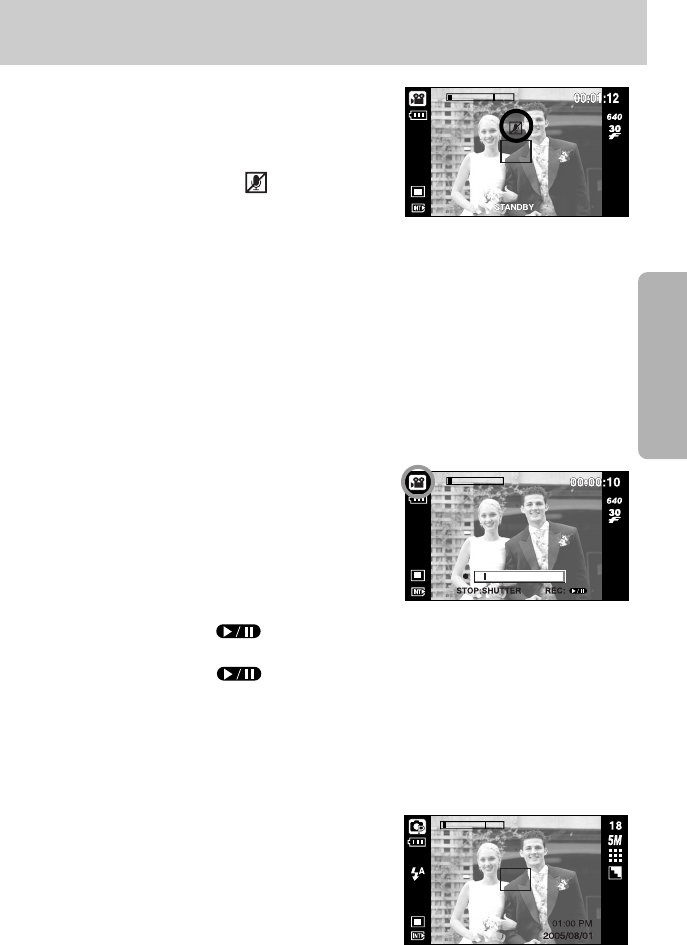
ŝ27Ş
ƈHow to use the Program mode
Selecting the automatic mode will configure the camera with optimal settings and you can
manually configure various functions.
1. Select the [FULL] sub menu on the [MODE] menu
(p.23).
2. Select the Program mode by pressing the M (Mode)
button (p.24).
3. Point the camera towards the subject and compose
the image by using the LCD monitor.
4. Press the shutter button to capture an image.
[PROGRAM mode]
ƈPausing while recording a movie clip (Successive Recording)
This camera allows you to temporarily stop during unwanted scenes, while recording a movie
clip. Using this function, you can record your favourite scenes into a movie clip without having
to create multiple movie clips.
ƃUsing Successive Recording
Steps from 1-2 are the same as those for MOVIE CLIP
mode.
3. Point the camera towards the subject and compose
the image by using the LCD monitor. Press the
shutter button and movie clips are recorded for as
long as the available recording time. Movie clips will
still be recorded if the shutter button is released.
4. Press the Pause button( ) to pause
recording.
5. Press the Pause button( ) again to resume the recording.
6. If you wish to stop recording, press the shutter button again.
ƈRecording the movie clip without voice
You can record the movie clip without voice.
Steps from 1-3 are the same as those for MOVIE CLIP
mode.
4. Press the Up button and the ( ) icon will display
on the LCD monitor.
5. Press the shutter button and movie clip is recorded
for as long as the available recording time without voice.
6. To stop the recording, press the shutter button again.
[
Successive recording of a movie clip
]
Starting the recording mode
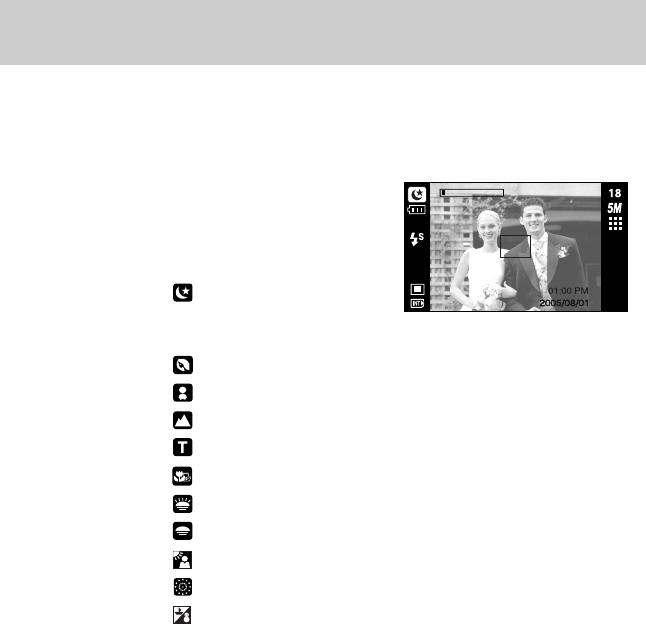
ŝ28Ş
Starting the recording mode
ƈHow to use the Scene modes
Use the menu to easily configure optimal settings for a variety of shooting situations.
1. Select the [FULL] sub menu on the [MODE] menu (p.23).
2. Select the Scene mode by pressing the M (Mode) button (p.24).
3. Point the camera towards the subject and compose
the image by using the LCD monitor.
4. Press the shutter button to capture an image.
ſThe scene modes are listed below.
[NIGHT] ( ) : Use this for shooting still
images at night or in
other dark conditions.
[PORTRAIT] ( ) : To take a picture of a person.
[CHILDREN] ( ) : To take a picture of fast moving objects, for example, children.
[LANDSCAPE] ( ) : To take pictures of distant scenery.
[TEXT] ( ) : Use this mode to shoot a document.
[CLOSE UP] ( ) : Close-up shooting for small objects such as plants and insects.
[DAWN] ( ) : Daybreak scenes.
[SUNSET] ( ) : For taking pictures of sunsets.
[BACKLIGHT] ( ) : Portrait without shadows caused by backlight.
[FIREWORKS] ( ) : Firework scenes.
[
BEACH&SNOW
]( ) : For ocean, lake, beach and snowscape scenes.
[SCENE mode]
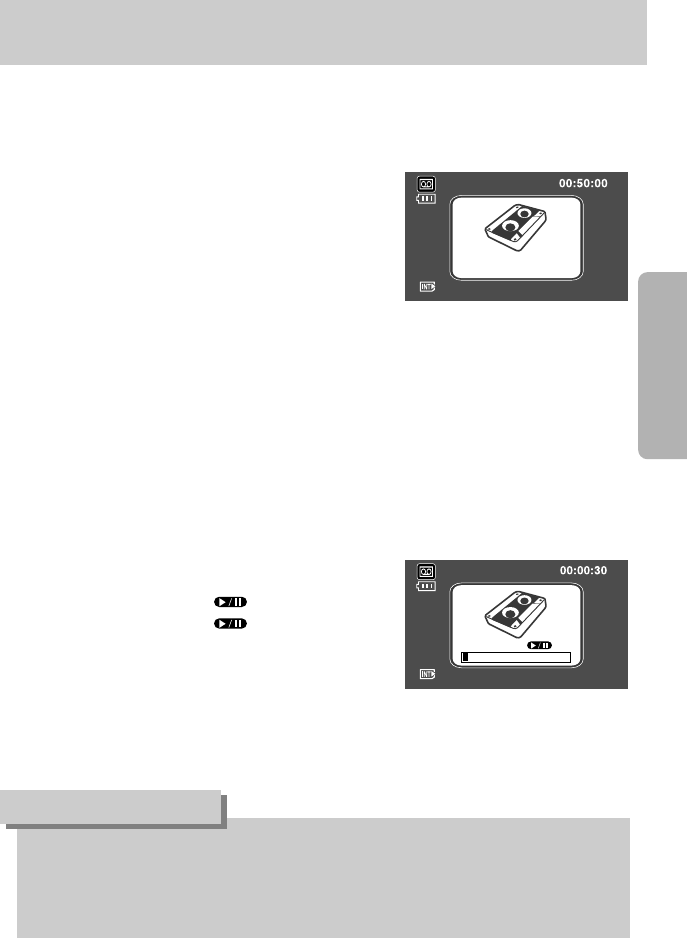
ŝ29Ş
ƃA distance of 40cm between you and the camera (microphone) is the best distance to
record sound.
ƃIf the camera power is turned off while the voice recording is paused, the voice recording
is cancelled.
INFORMATION
ƈHow to use the VOICE RECORDING mode
A voice recording can be recorded for as long as the available recording time of the memory
capacity allows. (Max: 1 hour)
1. In any mode with the exception of the Movie clip,
select the VOICE RECORDING mode by pressing
the Voice recording button twice.
2. Press the shutter button to record a voice.
- Press the shutter button once and voice is recorded
for as long as the available recording time (Max : 1
hour) allows. The recording time will be displayed on
the LCD monitor. Voice will still be recorded if the
shutter button is released.
- If you wish to stop recording, press the shutter button again.
- File type : WAV
[VOICE RECORDING mode]
[Pausing the voice recording]
RECORD :
RECORD : SHUTTER
ƃPausing while recording a voice recording
This camera allows you to temporarily stop during unwanted recording, while recording a
voice. Using this function, you can record your favorite voices into a voice recording file
without having to create multiple voice recording files.
1. Press the shutter button and voice is recorded for as long as the available recording time.
Voice will still be recorded if the shutter button is
released.
2. Press the Pause button( ) to pause recording.
3. Press the Pause button( ) again to resume the
recording.
4. If you wish to stop recording, press the shutter button
again.
Starting the recording mode
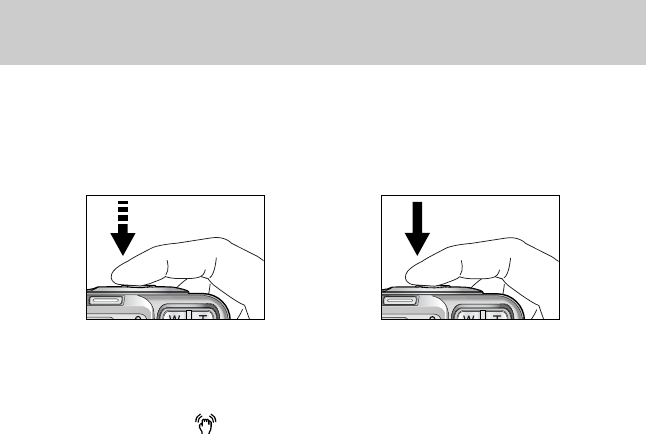
ŝ30Ş
ƈPressing the shutter button down half way
Lightly press the shutter button to confirm focus and flash battery charge.
Press the shutter button all way down to take the picture.
ƈThe available recording time may vary depending on shooting conditions and camera settings.
ƈWhen the Flash Off or Slow synchro mode is selected in a low lighting condition, the camera
shake warning indicator ( ) may appear on the LCD monitor. In this case, use a tripod,
support the camera on a solid surface or change the flash mode to flash shot mode.
ƈBacklight compensated shots : When taking an outdoor shot, avoid facing the sun, as the
image may be dark because of the strong backlight.
To take a picture against the sun, please use the
[BACKLIGHT] in the scene shooting mode (see page 28),
Fill-in flash (see page 37), Spot metering (see page 61), or
Exposure compensation (see page 52).
ƈAvoid obstructing the lens or the flash when you capture an image.
ƈUnder certain conditions the auto focus system may not perform as expected.
- When photographing a subject that has little contrast.
- If the subject is highly reflective or shiny.
- If the subject is moving at high speed.
- When there is strong reflected light, or when the background is very bright.
- When the subject matter has only horizontal lines or the subject is very narrow
(such as a stick or flagpole).
- When the surroundings are dark.
[Lightly press the shutter button] [Press the shutter button]
Things to Watch Out for When Taking Pictures
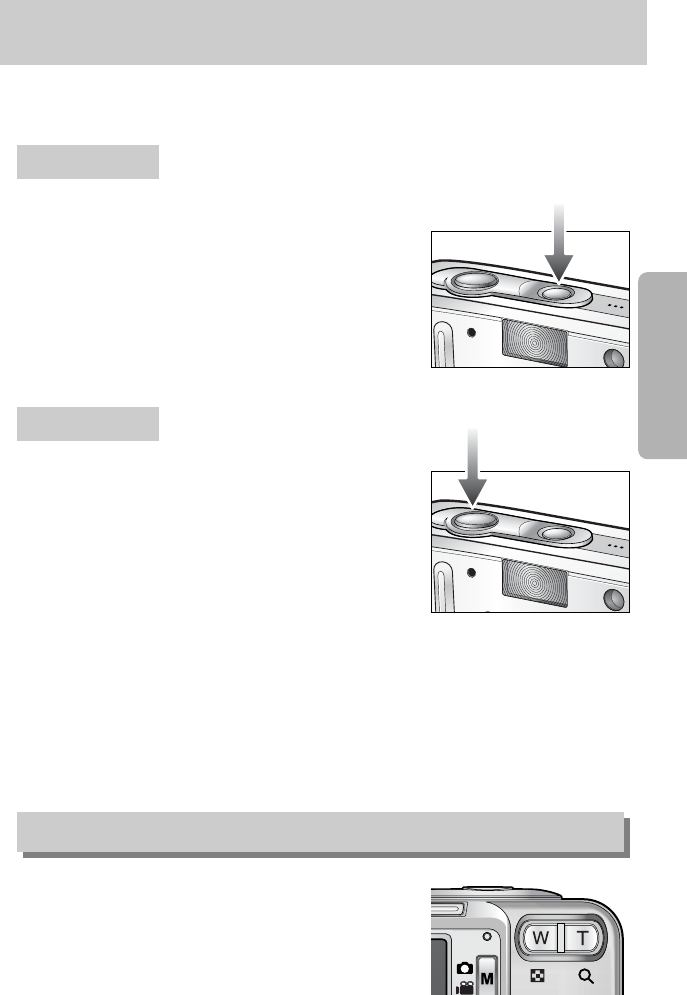
ŝ31Ş
Using the camera buttons to adjust the camera
ƈThe recording mode function can be set up by using the camera buttons.
POWER button
SHUTTER button
ƃIf the menu is not displayed, this button works as the
OPTICAL ZOOM or DIGITAL ZOOM button.
ƃUsed for turning the camera’s power on/ off.
ƃIf there is no operation during the specified time, the
camera's power will be turned off automatically to save
battery life. Refer to page 98 for more information about the
auto power off function.
ƃUsed for taking an image or recording voice in the recording
mode.
ƃIn MOVIE CLIP mode
Pressing the shutter button down fully starts the process for
recording a movie clip. Press the shutter button once and
the movie clip is recorded for as long as the available
recording time in the memory allows. If you wish to stop
recording, press the shutter button again.
ƃIn STILL IMAGE mode
Pressing the shutter button down halfway activates the autofocus and checks the condition of
the flash.
Pressing the shutter down fully takes the image and stores the relevant data regarding the
shot. If you select voice memo recording, the recording will start after the camera has finished
storing the image data for 10 seconds.
ZOOM W / T button
: When the camera is turned on, the power lamp turns on and off.
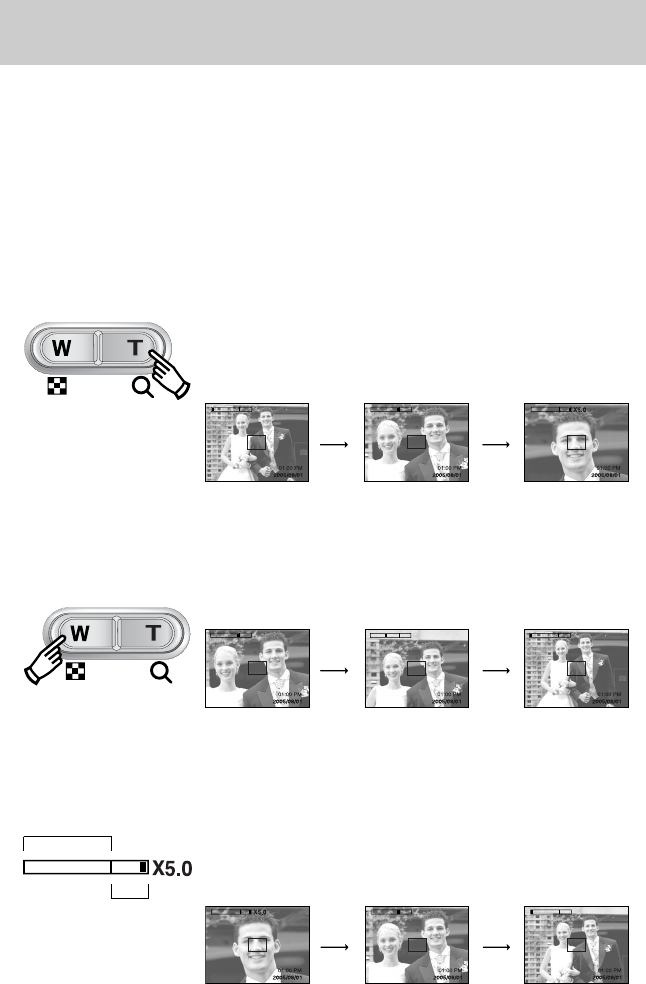
ŝ32Ş
ZOOM W / T button
ƈThis camera has a 4.8X optical zoom and a 5X digital zoom function. Using both will offer a
total zoom ratio of 24X.
ſThe illustrations as shown below are for your information about using the W/ T button.
The pre-view images are can be different with the illustrations.
ƃTELE Zoom
Optical zoom TELE : Pressing the ZOOM T button. This will zoom into the subject i.e.
the subject will appear nearer.
Digital zoom TELE : When the maximum (4.8X) optical zoom is selected, pressing the
ZOOM T button activates the digital zoom software. Releasing
ZOOM T button stops the digital zoom at the required setting.
Once the maximum digital zoom (5X) is achieved, pressing the
ZOOM T button will have no effect.
[ WIDE zoom ] [ TELE zoom ]
[ Digital zoom 5.0X ]
Pressing the
ZOOM T button
Pressing the
ZOOM T button
ƃWIDE Zoom
Optical zoom WIDE : Pressing the ZOOM W button. This will zoom out from the subject
i.e. the subject will appear further away. Pressing the ZOOM W
button continuously will set the camera to its minimum zoom
setting i.e. the subject appears at its furthest from the camera.
Digital zoom WIDE : When the digital zoom is in operation, pressing the ZOOM W
button will reduce the digital zooming in steps.
Releasing ZOOM W button stops digital zooming.
Pressing the ZOOM W button will reduce the digital zoom and
then it will continue to reduce the optical zoom until the minimum
setting is reached.
[ TELE zoom ] [ Optical zoom 2X ] [ WIDE zoom ]
Pressing the
ZOOM W button
Pressing the
ZOOM W button
[ Digital zoom 5.0X ]
[ TELE zoom ] [ WIDE zoom ]
Pressing the
ZOOM W button
Pressing the
ZOOM W button
Optical zoom
Digital zoom

ŝ33Ş
ƃImages taken using the digital zoom may take a little longer for the camera to process.
Allow time for this to take place.
ƃYou may notice a decrease in image quality when using the digital zoom.
ƃTo view more clear digital zoom image, press the shutter button halfway at the maximum
(4.8X) optical zoom position and press the zoom T button again.
ƃThe digital zoom can’t be activated in the [NIGHT], [CHILDREN], [CLOSE UP], [TEXT]
and [FIREWORKS] scene modes.
ƃTake care not to press the lens, lens cover and camera by force. This may cause the
camera malfunction.
INFORMATION
ZOOM W / T button
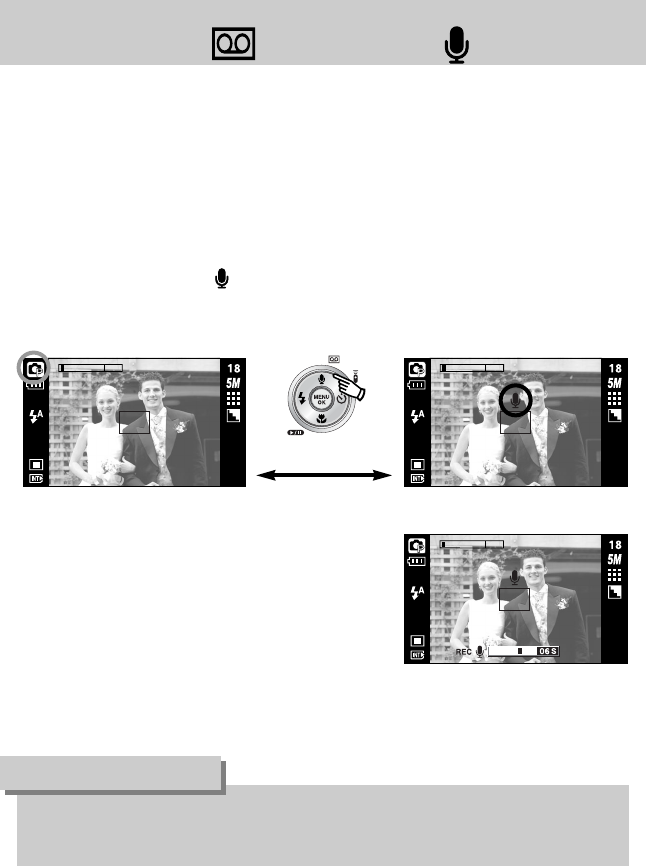
ŝ34Ş
Voice recording( ) / Voice memo( ) / UP button
ƃA distance of 40cm between you and the camera (microphone) is the best distance to
record sound.
INFORMATION
ƈWhile the menu is showing, press the UP button to move up the submenu cursor.
When the menu is not displayed on the LCD monitor, the UP button operates as the voice
recording or voice memo button. You can record your voice or add your voice-over to a stored
still image. Refer to page 29 for more information about the voice recording.
ƃRecording a voice memo
1. Press the M (Mode) button to select a Recording mode with the exception of Movie clip
mode.
2. Press the Voice memo ( ) button. If the voice memo indicator is displayed on the LCD
monitor, the setting is completed.
3. Press the shutter button and take a picture.
The picture is stored on the memory.
4. Voice memo will be recorded for ten seconds
from the moment the picture is stored. In the
middle of the voice recording, pressing the
shutter button will stop the voice memo.
Pressing the Voice memo button
[Recording Voice Memo]
STOP: SHUTTER
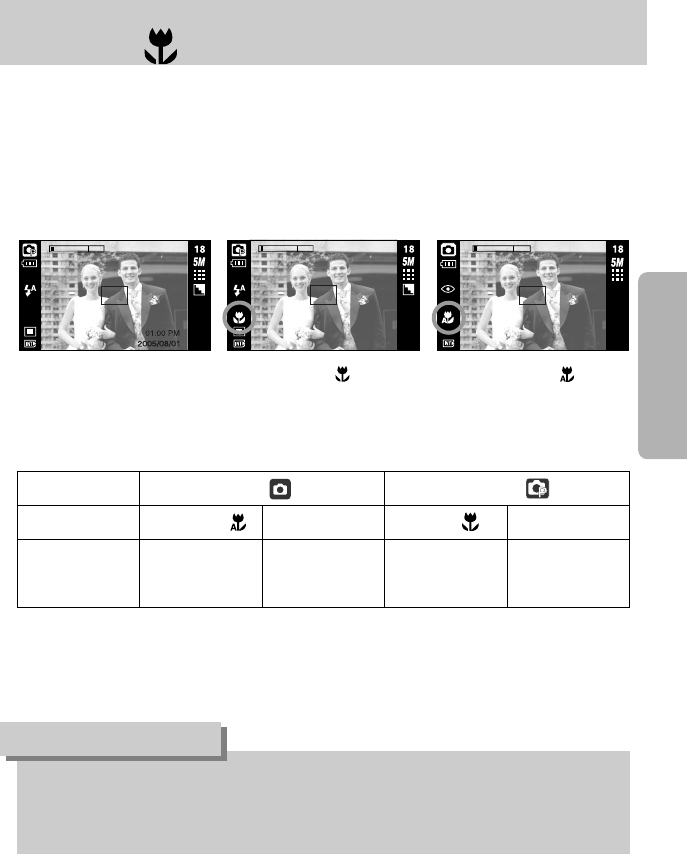
ŝ35Ş
ƈWhile the menu is showing, press the DOWN button to move from the main menu to a
submenu, or to move down the submenu cursor. When the menu is not showing, you can
use the MACRO/ DOWN button to take macro pictures. The distance ranges are shown
below. Press the Macro button until the desired macro mode indicator displays on the LCD
monitor.
[Auto macro ( )][Macro ( )]
[Auto focus - No icon]
ƃWhen the macro mode is selected, it is possible that camera shake will occur. Take care
not to shake the camera.
ƃWhen you take a picture within 30cm in the Macro mode, select the FLASH OFF mode.
INFORMATION
ƈTypes of focus modes and focus ranges (W: Wide, T: Tele)
ſSee the next page for the available focusing method, by recording mode.
(Unit : cm)
Mode
Focus Type Auto macro ( ) Normal Macro ( ) Normal
Focus range W : 5~Infinity
T : 14~Infinity
W : 80~Infinity
T : 80~Infinity
W : 80~Infinity
T : 80~Infinity
W : 2~80
T : 14~80
Program ( )
Auto ( )
Macro( ) / Down button
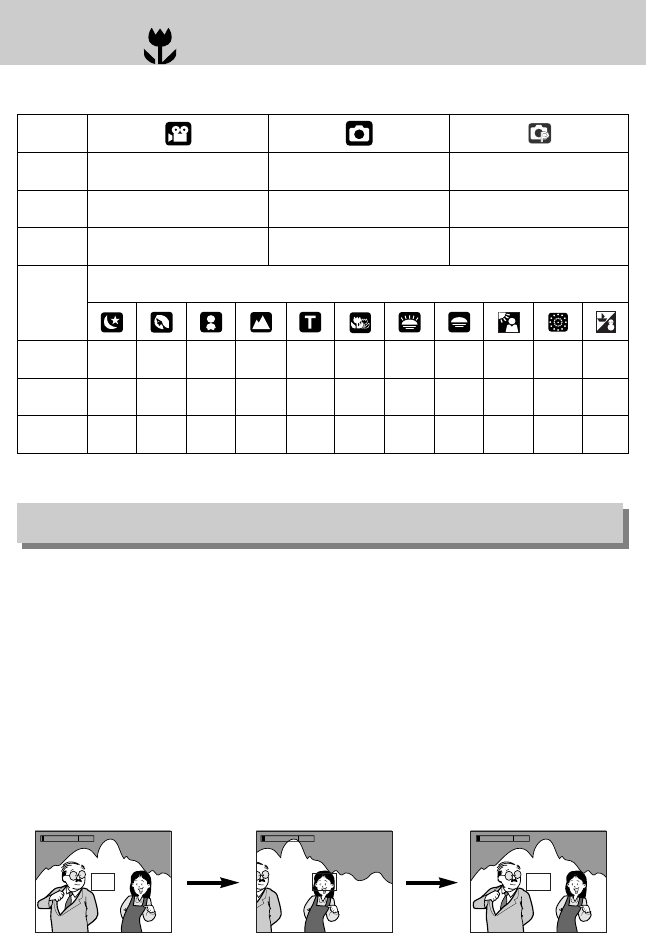
ŝ36Ş
Macro( ) / Down button
ƈ
Available focusing method, by recording mode ( O: Selectable , X: Not selectable, ∞: Infinity focus range)
ƈTo focus on the subject positioned outside of the centre, use the focus lock function.
ƃUsing the Focus Lock
1. Ensure the subject is in the centre of the autofocus frame.
2. Press the SHUTTER button halfway. When the green auto focus frame lights up, it means
the camera is focused on the subject. Be careful not to press the SHUTTER button all the
way down to avoid taking an unwanted picture.
3. With the SHUTTER button still pressed down only halfway, move the camera to
recompose your picture as desired, and then press the SHUTTER button completely to
take the picture. If you release your finger from the SHUTTER button, the focus lock
function will be cancelled.
Focus lock
OOO
OXO
XOX
SCENE
Mode
Normal
Macro
Auto macro
Normal
Macro
Auto macro
Mode
OO O ūXXūū OūO
XX X XXO XXX XX
XX X XOX XXX XX
1. The image to be
captured.
2. Press the SHUTTER
button halfway and focus
on the subject.
3. Recompose the picture and
fully depress the SHUTTER
button.
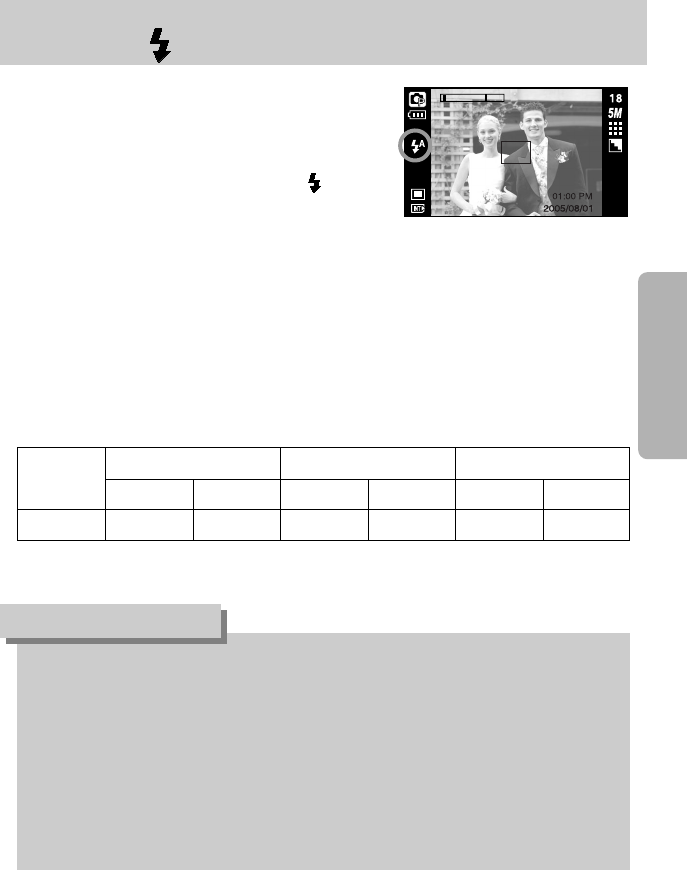
ŝ37Ş
Flash ( ) / Left button
[Selecting the Auto flash]
ƃFlash range (Unit : m)
ƈWhen the menu is displayed on the LCD monitor,
pressing the LEFT button makes the cursor shift to the
left tab.
ƈWhen the menu is not displayed on the LCD monitor,
the LEFT button operates as the FLASH ( ) button.
ƃSelecting the flash mode
1. Press the M (Mode) button to select a Recording
mode with the exception of Movie clip mode (p.24).
2. Press the Flash button until the desired flash mode
indicator displays on the LCD monitor.
3. A flash mode indicator will be displayed on the LCD monitor.
Use the correct flash to suit the environment.
ƃIf you press the shutter button after selecting the Auto, Fill-in, Slow sychro flash, the first
flash fires to check the shooting condition (Flash range and Power ratio of flash).
Do not move until the second flash fires.
ƃUsing the flash frequently will reduce the life of the battery.
ƃUnder normal operating conditions the charging time for the flash is normally within 5
seconds. If the battery is weak, the charging time will be longer.
ƃDuring the continuous shot, AEB and movie clip mode, the flash function will not operate.
ƃTake photographs within the flash range.
ƃThe image quality is not guaranteed if the subject is too close or highly reflective.
INFORMATION
Normal
WIDE TELE WIDE TELE WIDE TELE
0.8 ~ 3.0 0.8 ~ 2.0 0.3 ~ 0.8 0.3 ~ 0.8 0.3 ~ 3.0 0.3 ~ 2.0
Macro Auto macro
ISO
AUTO
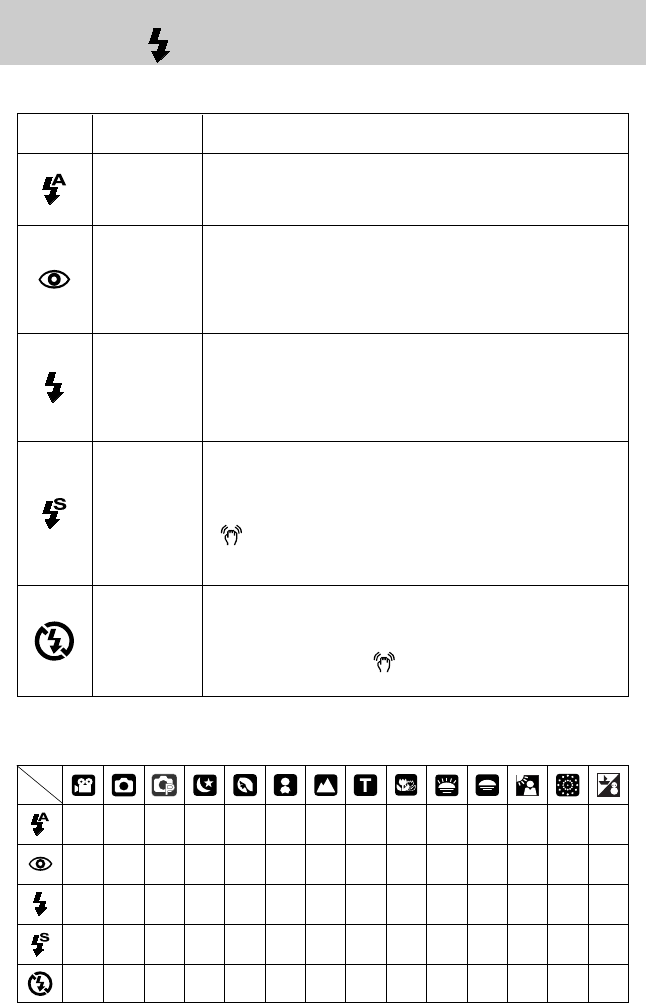
ŝ38Ş
Flash ( ) / Left button
Menu tab Flash mode Description
ƃFlash mode indicator
If the subject or background is dark, the camera flash will operate
automatically.
Auto flash
Auto &
Red eye
reduction
Fill in flash
Slow synchro
Flash off
If a subject or background is dark, the camera flash will work
automatically and will reduce the red-eye effect by using the red-
eye reduction function.
The flash will operate in conjunction with a slow shutter speed in
order to obtain the correct exposure. When you take an image in
a condition with poor light, the camera shake warning indicator
( ) will display on the LCD monitor.
We recommend using a tripod for this function.
The flash fires regardless of available light.
The intensity of the flash will be controlled, according to the
prevailing conditions. The brighter the background or subject is,
the less intense the flash will be.
The flash does not fire. Select this mode when capturing images
in a place or situation where flash photography is prohibited.
When you capture an image in a poorly lit condition, the camera
shake warning indicator ( ) will display on the LCD monitor.
We recommend using a tripod for this function.
ƃAvailable flash mode, by recording mode
XXOX XX XXXX XXXO
XOOX OO XXXX XX XX
XXOX XX XXXX XOXX
XXOOXXXXXXXXXX
OOO O OOOOOO OX OX
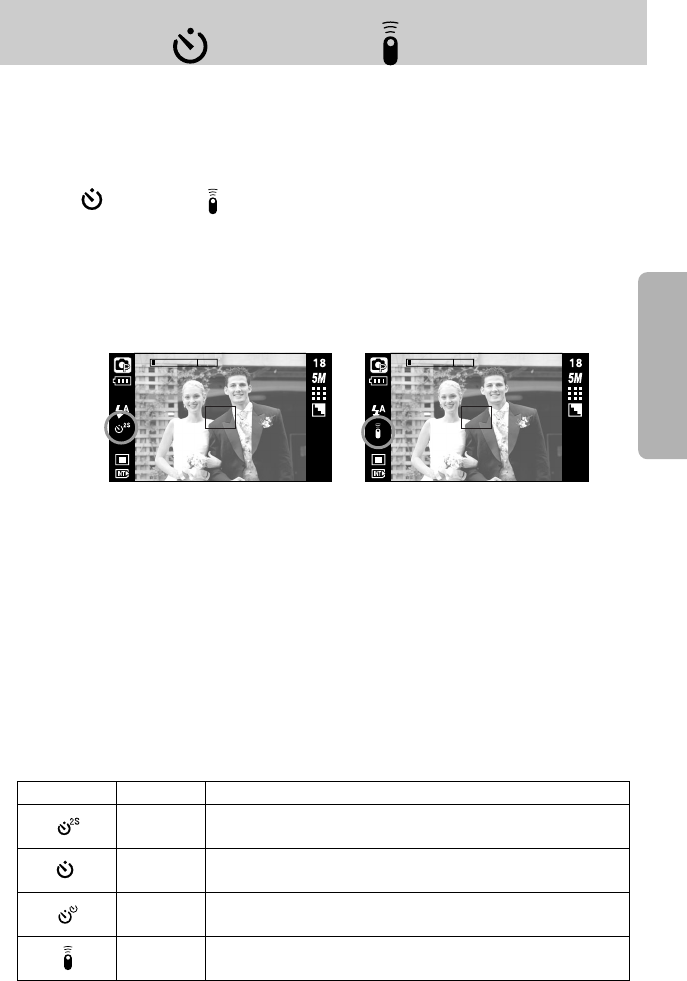
ŝ39Ş
Self-timer( ) / Remote ( ) / Right button
ƈWhen the menu is displayed on the LCD monitor, pressing the Right button makes the cursor
shift to the right tab. The right button can also be used to move to a sub menu to select a
different setting.
ƈWhen the menu is not displayed on the LCD monitor, the RIGHT button operates as the Self-
timer ( ) and Remote ( ) button. This function is used when the photographer would
also like to be in the image.
ƃUsing the self-timer and remote control
1. Press the M (Mode) button to select a still image mode or movie clip mode (p.24).
2. Press the SELF-TIMER button until the desired mode indicator displays on the LCD
monitor. A self-timer icon or remote control icon appears on the LCD monitor.
- Selecting a self-timer : When you press the Shutter button, the picture will be taken after the
specified time has elapsed and the self-timer function will be canceled.
- Selecting a remote mode : Pressing the shutter button of remote control will allow an interval of
2 seconds before the image is taken. In the remote mode, the
shutter button of the camera canŖt be activated. After taking a
picture, the remote mode will be maintained. But, pressing the
Power button, Mode button, Play mode button and Self-timer button
will cancel the remote mode.
[Selecting the 2 SEC self-timer] [Selecting the remote control]
ƃDescription of Self-timer/ Remote mode
Icon Mode Description
Pressing the shutter button will allow an interval of 2 seconds
before the image is taken.
Pressing the shutter button will allow an interval of 10 seconds
before the image is taken.
A picture will be taken after about 10 seconds and 2 seconds
later a second picture will be taken.
You can take a picture by remote control instead of using the
shutter button of the camera.
Double
10s
2s
Remote
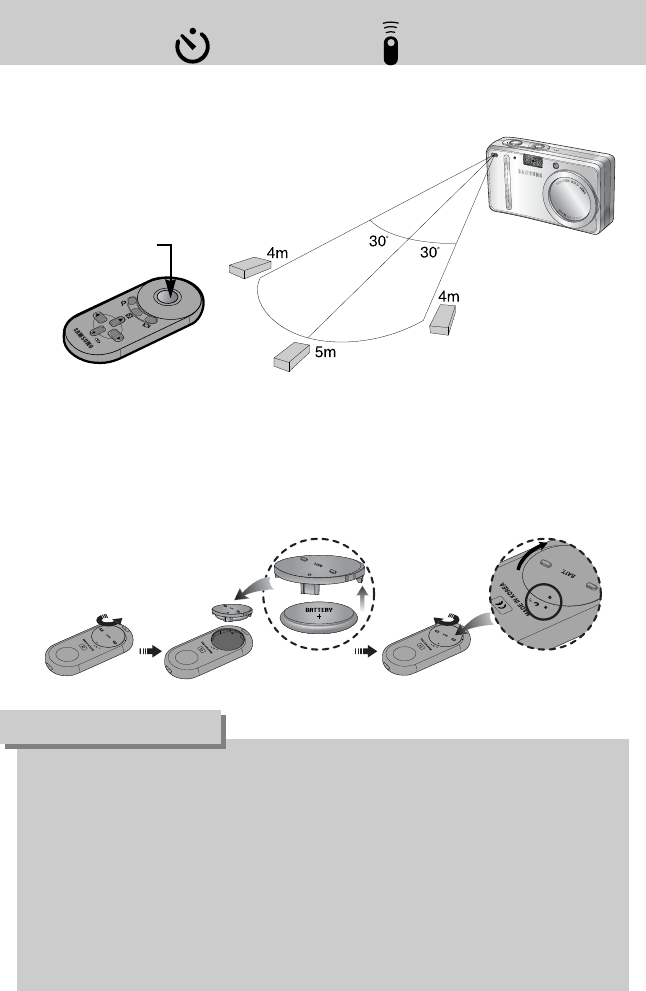
ŝ40Ş
ƃRemote control range
When you take a picture by using the remote control, refer to the
illustrations shown alongside about the remote control range.
[ Shutter button on the
remote control ]
ƃWhen taking a picture using the self-timer, the self-timer lamp works as follows:
2 second self-timer setting : The self-timer lamp blinks at 0.25 second interval for 2
seconds.
10 second self-timer setting : The self-timer lamp blinks at 1 second interval for the first 8
seconds. It blinks at 0.25 second interval for the remaining
2 seconds.
ƃIf you operate the Self-timer button and Play mode button during the self-timer operation,
the self-timer function is canceled.
ƃUse a tripod to prevent the camera from shaking.
ƃIn Movie Clip mode, only the 10s self-timer and remote will work.
INFORMATION
ƃReplacing battery for the remote control
Make sure the + polarity is toward the top and the - polarity is toward the bottom while
installing battery for the remote control. Replace battery for the remote control in the local
service centre. Use the CR 2025 3V battery.
Self-timer( ) / Remote ( ) / Right button
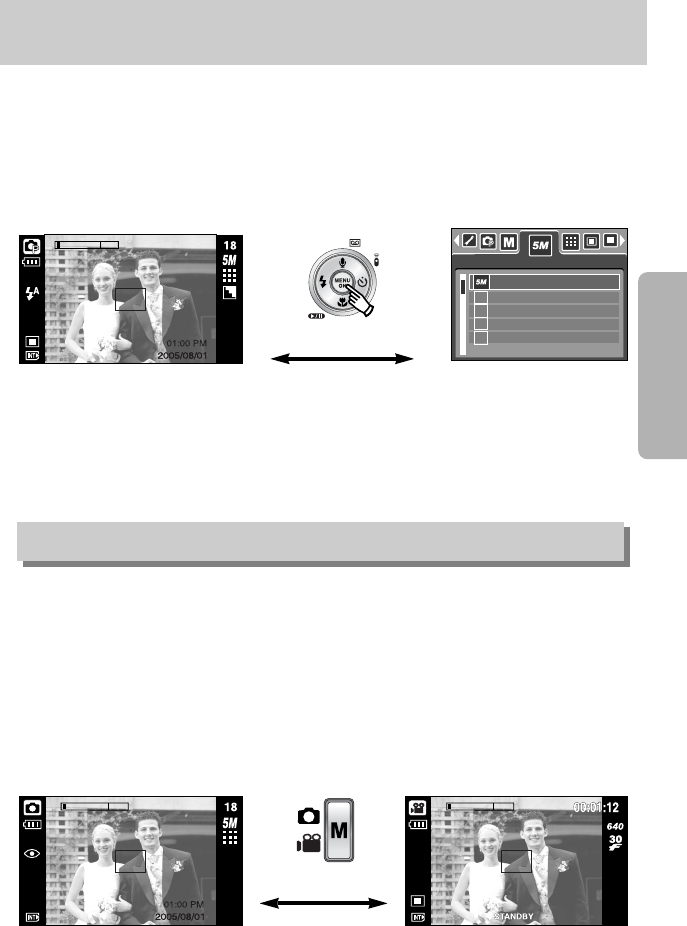
ŝ41Ş
MENU / OK button
ƈMENU button
- When you press the MENU button, a menu related to each camera mode will be displayed
on the LCD monitor. Pressing it again will return the LCD to the initial display.
- A menu option can be displayed when the following are selected :
MOVIE CLIP and STILL IMAGE mode. There is no menu available when the VOICE
RECORDING mode is selected.
ƈOK button
- When the menu is displayed on the LCD monitor, this button is used for shifting the cursor
to the sub menu or for confirming data.
Pressing the MENU button
[Menu off]
[Auto mode]
[Menu on]
ƈYou can turn on the camera with this button.
ƈYou can select the desired recording mode. The selectable recording modes are different
from what you selected sub menu in the [MODE] menu.
- [STILL & MOVIE] : A recording mode selected in the [MODE SET] menu, Movie clip mode
- [FULL] : Auto, Movie clip, Program, Scene modes
- [CUSTOM] : Modes set as on in the [MODE SET] menu
ƃHow to use the mode button : In case of [STILL & MOVIE] sub menu and Auto mode
[Pressing the M button]
M (Mode) button
SIZE
2592X1944
2272X1704
2048X1536
1600X1200
1024X768
4M
3M
2M
1M
[Movie clip mode]
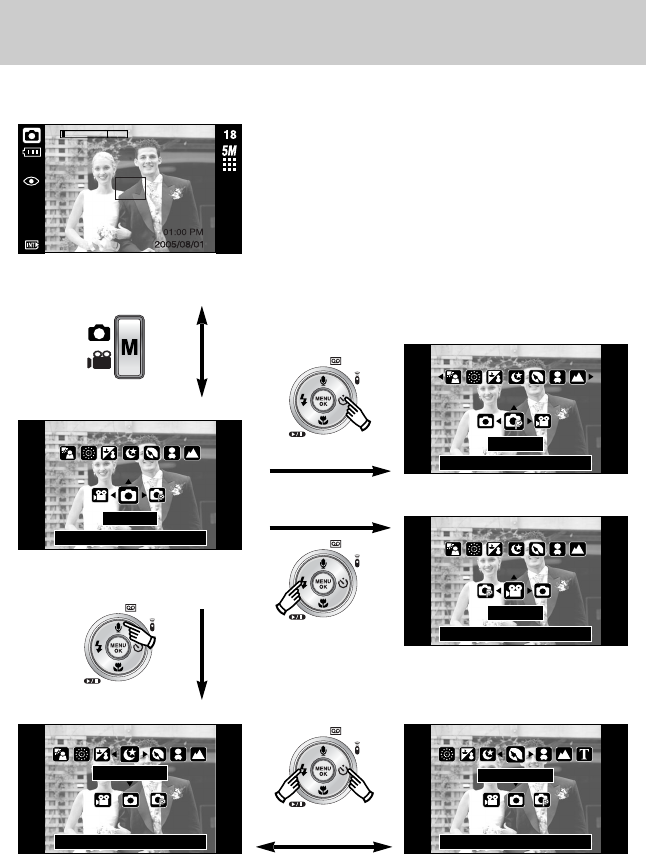
ŝ42Ş
[Pressing the Up button]
ƃHow to use the mode button : In case of [FULL] sub menu and Auto mode
ſPress the Mode button and the mode selection menu will disappear.
[Pressing the Right button]
[Pressing the Left/ Right button]
[Pressing the Left button]
[Auto mode]
[Program mode]
[Pressing the Mode button]
[Selecting a scene mode]
PORTRAIT
PROGRAM
[Mode selection menu]
AUTO
SET:OK
[Scene mode]
NIGHT
MOVIE
[Movie cliip mode]
SET:OK SET:OK
SET:OK
SET:OK
M (Mode) button
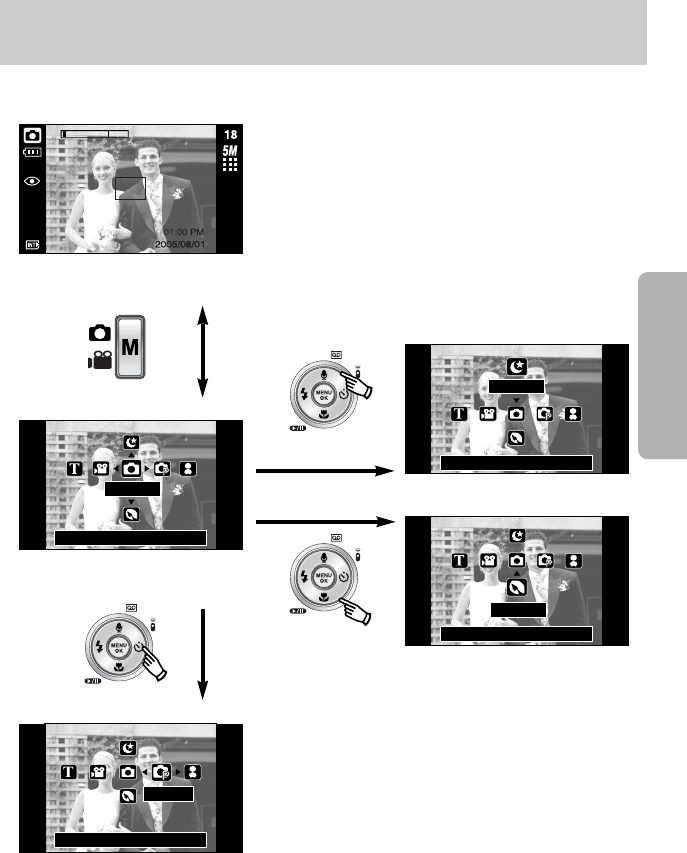
ŝ43Ş
M (Mode) button
[Pressing the Right button]
ƃHow to use the mode button : In case of [CUSTOM] sub menu and Auto mode
ſPress the Mode button and the mode selection menu will disappear.
ſThe illustrated images and modes are for your
information.
They can be changed as the [MODE SET] menu
setting.
[Pressing the Up button]
[Pressing the Down button]
[Auto mode]
[Portrait scene mode]
[Pressing the Mode button]
[Program mode]
PROGRAM
PORTRAIT
[Mode selection menu]
AUTO
[Night scene mode]
SET:OK
SET:OK
SET:OK
SET:OK
NIGHT
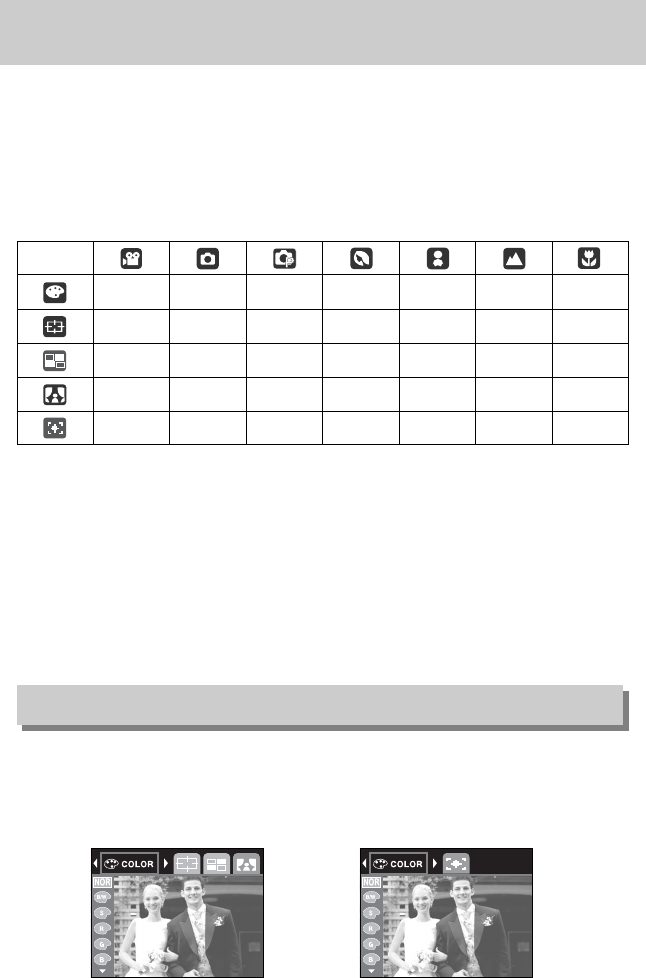
ŝ44Ş
E (Effect) button
ƈIt is possible to add special effects to your images by using this button
ƈStill image mode : You can select the colour, focus, composite and frame menus.
Movie clip mode : You can select the colour and stabiliser menus.
ƈAvailable Effects, by recording mode (O : Selectable X : Not selectable)
ſThis button will not operate in the Voice recording mode and some scene modes (Night, Text,
Sunset, Dawn, Backlight, Fireworks and Beach & Snow)
If a special effect is selected, the rest special effect (FOCUS, COMP. FRAME) functions set
before are cancelled automatically.
ſIf you select a TIFF file format, only the COLOR menu can be selected.
ƈEven if the camera is turned off, the special effect setting will be preserved.
To cancel the special effect, select the [OFF] sub menu of each menu.
ƈBy using the camera’s digital processor, it is possible to add special effects to your images
1. Press the E button in the still image mode or Movie clip mode.
2. Select the COLOR menu by pressing the Left/ Right button.
Special Effect : Colour
OOOOOOO
XXOXXXX
XXOXXXX
XXOXXXX
OXXXXXX
NORMAL
[Still image mode] [Movie clip mode]
NORMAL
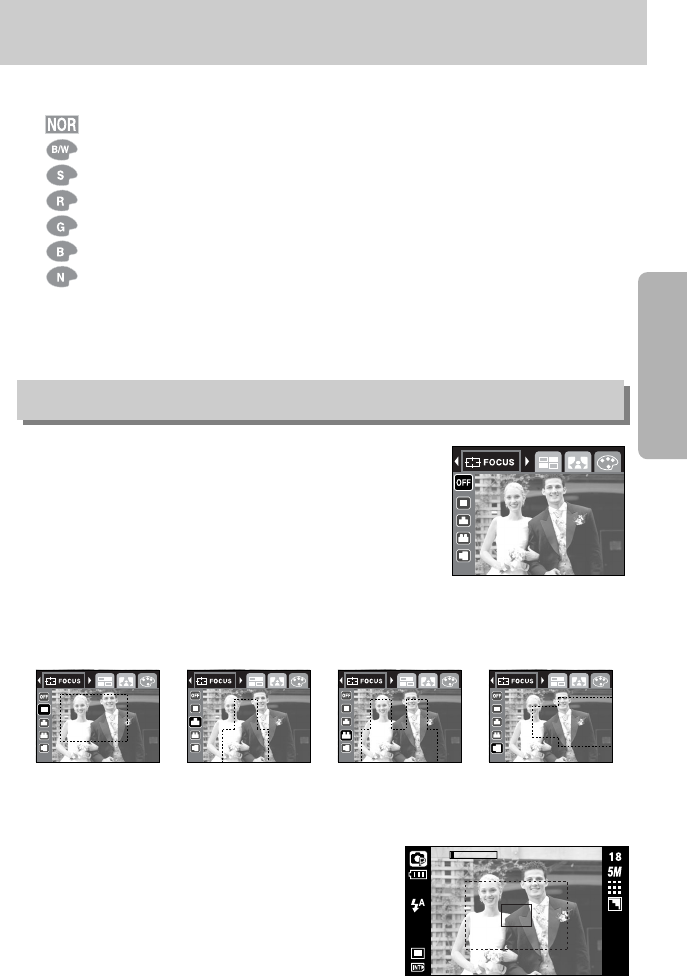
ŝ45Ş
[Range 1]
ƈYou can make the subject stand out from its surroundings.
The subject will be sharp and in focus while making the
rest out of focus.
1. Press the E button in the program mode.
2. Select the FOCUS menu by pressing the Left/ Right
button.
3. Select a desired sub menu by pressing the Up/ Down
button and press the OK button.
4. The preset focus frame will appear.
Press the shutter button to capture an image
[Range 2] [Range 3] [Range 4]
Special Effect : Preset focus frames
3. Select a desired sub menu by pressing the Up/Down button and press the OK button.
: No effect is added to the image
: Captured images will be stored in black and white.
:
Captured images will be stored in a sepia tone (a gradient of yellowish brown colours).
: Captured images will be stored in a red tone.
: Captured images will be stored in a green tone.
: Captured images will be stored in a blue tone.
: Save the image in negative mode.
4. Press the shutter button to capture an image.
Special Effect : Colour
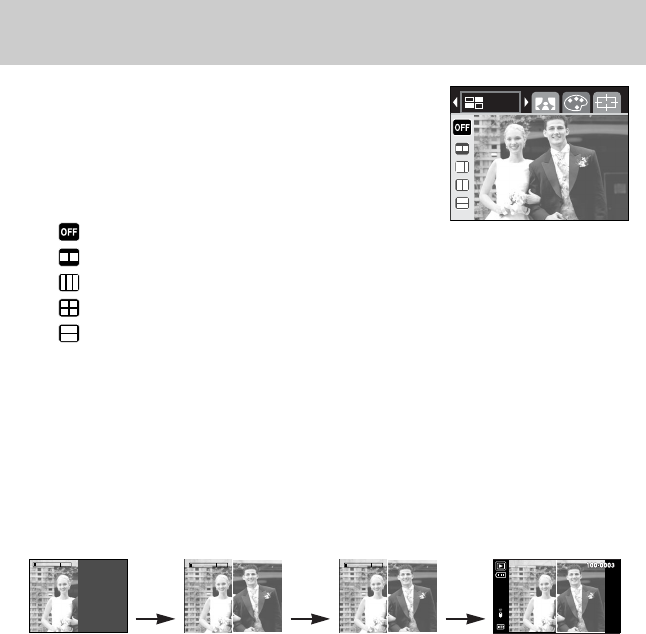
ŝ46Ş
ƈYou can combine 2 ~ 4 different shots in a still image.
1. Press the E button in the program mode.
2. Select the COMP. menu by pressing the Left/ Right button.
3. Select a desired sub menu by pressing the Up/ Down
button and press the OK button.
- : cancels the composite shooting
- : 2 different shots are combined in a still image.
- : 3 different shots are combined in a still image.
- : 4 different shots are combined in a still image.
- : 2 different panorama shots are combined in a still image.
4. The number of frames you selected in step 3 is displayed on the LCD monitor.
Press the shutter button to start the composite shooting
COMP.
ſYou can use the flash button, self-timer button, macro button, voice memo button and the
Zoom W/T button during the composite shooting.
ſIf you press the camera buttons (Play mode button, M button, E button, Menu button and
Wide button) during the composite shots or press the voice recording button twice, each
mode of the camera buttons is executed. The images captured before will be deleted.
ſThe voice memo will start after taking the last composite shooting.
[Ready for taking]
Pressing the
shutter button
Pressing the
shutter button
[First shot] [Second shot] [The final picture]
ſSelecting 2 composite shooting
5. After taking the last shot, the image will be saved.
Special Effect : Composite shooting
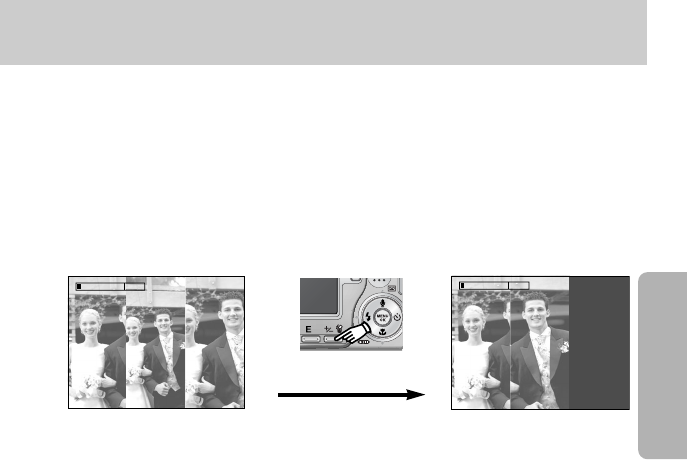
ŝ47Ş
Special Effect : Composite shooting
ƃChanging a part of composite shot before taking the last shot
Before taking the last composite shot, you can change a part of composite shot.
1. During the composite shots, press the +/- button.
2. A previous image will be deleted and new frame will display.
If there is an image taken before, press the +/- button again and a previous image will be
deleted again.
3. Press the shutter button to capture a new image.
Pressing the +/- button
[Before taking the 3rd shot]
[Moving backward to the 2nd shot]
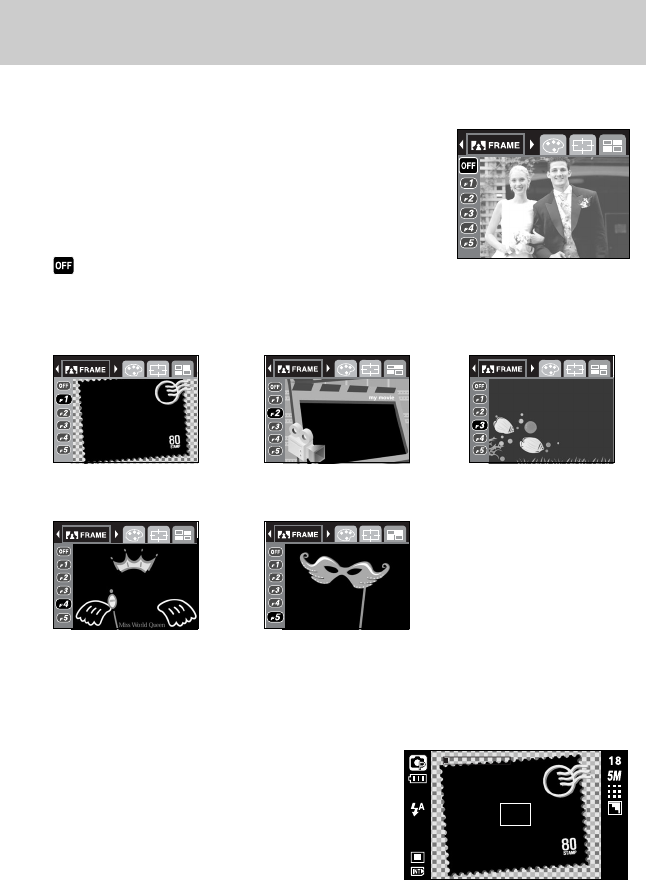
ŝ48Ş
ƈYou can add 5 types of frame-like borders to a still image you want to capture.
1. Press the E button in the program mode.
2. Select the FRAME menu by pressing the Left/ Right
button.
3. Select a desired sub menu by pressing the Up/ Down
button and press the OK button.
- : The photo frame will not be added.
4. The photo frame will appear.
Press the shutter button to capture an image
Special Effect : Photo Frame
[Frame 1] [Frame 2]
[Frame 4] [Frame 5]
[Frame 3]
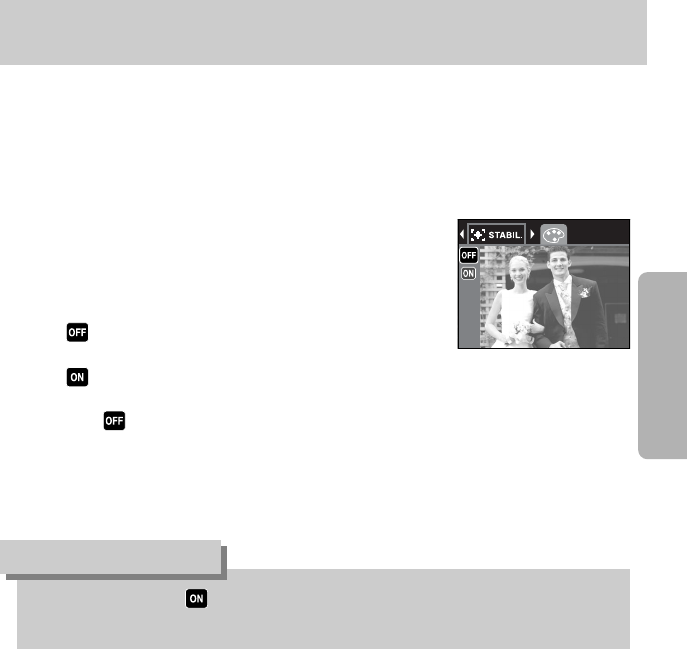
ŝ49Ş
ƈThis function helps stabiliser images captured during movie recording.
You can select this menu only in the MOVIE CLIP mode.
ƃHow to use this function
1. Press the E button in the Movie clip mode.
2. Select the STABIL. menu by pressing the Left/ Right
button.
3. Select a desired sub menu by pressing the Up/
Down button and press the OK button.
- : Movie clip frame stabiliser function becomes
disabled.
- : Prevents camera shake during movie recording.
The recording frame range will become narrower than when you select the
menu. Pre-view frames may not display smoothly on the LCD monitor.
ƃWhen you select the sub menu, the movie clip frame range will be narrow depending
on the movie clip size.
INFORMATION
Movie Clip frame stabiliser
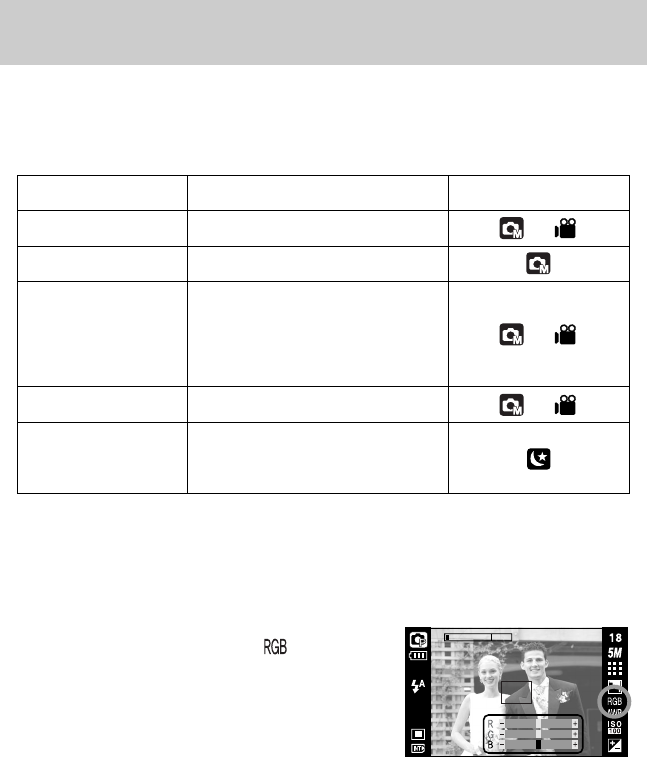
ŝ50Ş
+/- button
ƈYou can use the +/- button to adjust the values for the RGB, ISO, white balance, exposure
compensation and Long Time shutter speed.
ƈRGB : Allows the user to adjust the R (Red), G (Green), and B (Blue) values of the images to
be captured.
ƃSetting RGB Values
1. Press the +/- button, and then use the UP and DOWN
buttons to select the RGB icon ( ).
The RGB menu bar will appear as shown.
2. Use the UP/ DOWN/ LEFT and RIGHT buttons to
select the desired RGB value.
- Up/ Down Button : Navigates between R, G, and B
icons.
- Left/ Right Button : Changes value of each icon.
3. When you press the +/- button again, the value you set will be saved and RGB setup
mode will end.
Main menu Sub menu Available camera mode
RGB R (Red), G (Green), B (Blue)
ISO AUTO, 50, 100, 200, 400
WHITE BALANCE
Exposure compensation -2.0 ~ 0.0 ~ +2.0 (0.3EV steps)
LT Shutter speed/ Aperture Value
(Changed by zoom rate)
AUTO, DAYLIGHT, CLOUDY,
FLUORESCENT H,
FLUORESCENT L, TUNGSTEN,
CUSTOM.
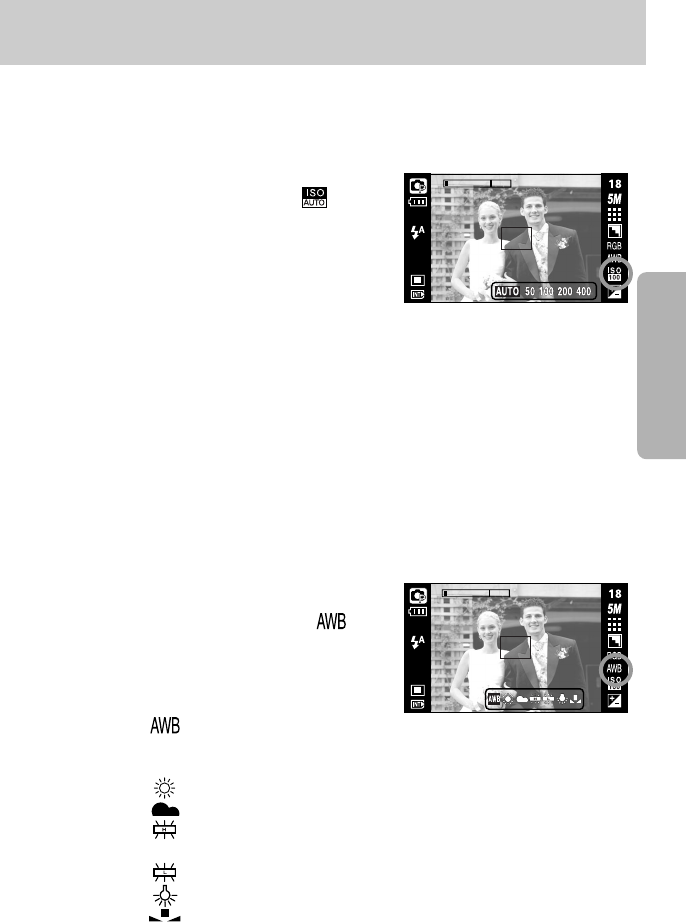
ŝ51Ş
+/- button
ƃSelecting an ISO Sensitivity
1. Press the +/- button, and then use the UP and
DOWN buttons to select the ISO icon( ). The
ISO menu bar will appear as shown.
2. Use the LEFT and RIGHT buttons to select the
desired ISO sensitivity value.
- AUTO : The camera's sensitivity is automatically
changed by variables such as lighting value or
subject brightness.
- 50, 100, 200, 400 : You can increase the shutter speed while the same amount of light is
present, by increasing the ISO sensitivity. However, the image may be saturated in high
luminance. The higher the ISO value, the higher the camera’s sensitivity to light is and
therefore the greater its capacity to take pictures in dark conditions. However, the noise
level in the image will increase as the ISO value increases, making the image appear
coarse.
3. When you press the +/- button again, the value you set will be saved and ISO setup mode
will end.
ƈWhite balance : The white balance control allows you to adjust the colours to appear more
natural looking.
ƃSelecting a White Balance
1. Press the +/- button, and then use the UP and DOWN
buttons to select the white balance icon ( ).
The white balance menu bar will appear as shown.
2. Use the LEFT and RIGHT buttons to set the white
balance to the desired value. The value you set will
be displayed on the LCD monitor.
AUTO : The camera automatically
selects the appropriate white balance settings, depending on the
prevailing lighting conditions.
DAYLIGHT : For taking images outside.
CLOUDY : For taking images under a cloudy and overcast sky.
Fluorescent H : For shooting under daylight fluorescent types of three-way
fluorescent lighting.
Fluorescent L : Shooting under white fluorescent lighting.
TUNGSTEN : For shooting under tungsten (standard light bulb) lighting.
CUSTOM : Allows the user to set the white balance according to the shooting
condition.
Different lighting conditions may cause a colour cast on your images.
3. Press the +/- button again. The value you set will be saved and White Balance setup mode
will end.
ƈISO : You can select the ISO sensitivity when taking pictures.
The speed or specific light-sensitivity of a camera is rated by ISO numbers.
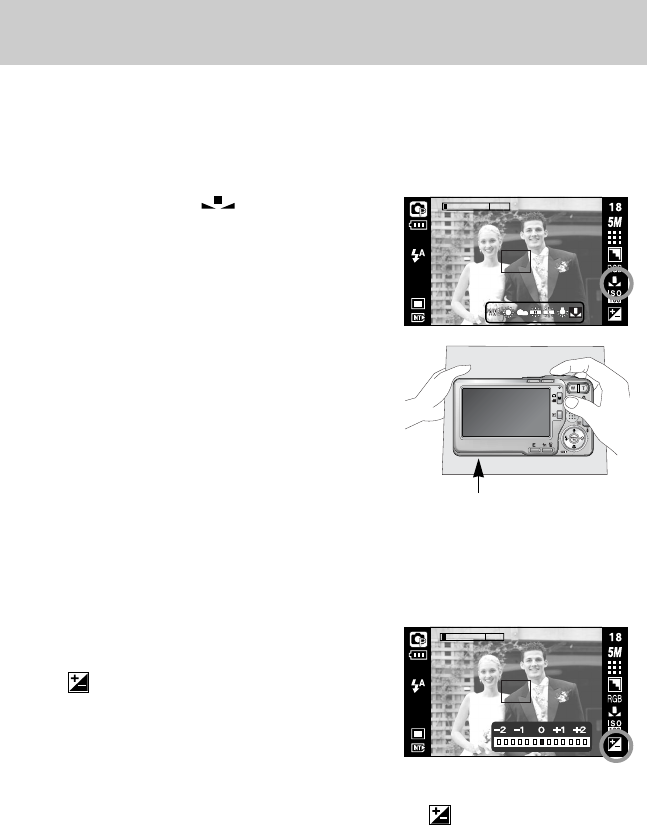
ŝ52Ş
+/- button
ƃUsing the Custom White Balance
White balance settings may vary slightly depending on the shooting environment.
You can select the most appropriate white balance setting for a given shooting environment
by setting up the custom white balance.
1. Select the CUSTOM ( ) menu of the White
Balance.
2. Place a sheet of white paper in front of the camera so
that the LCD monitor shows only white, and then
press the SHUTTER button.
3. Your custom white balance value is stored.
- The custom white balance value will be applied,
starting with the next picture you take.
- The user configured white balance will be remain
effective until it is overwritten.
[ White paper ]
ƈExposure compensation : This camera automatically adjusts the exposure according to the
ambient lighting conditions.
You can also select the exposure value by using the +/- button.
ƃCompensating Exposure
1. Press the +/- button, and then use the UP and DOWN
buttons to select the exposure compensation icon
( ). The exposure compensation menu bar will
appear as shown.
2. Use the LEFT and RIGHT buttons to set the desired
exposure compensation factor.
3. Press the +/- button again. The value you set will be
saved and the Exposure Compensation setup mode will close.
If you change the exposure value, the exposure indicator ( ) will be displayed on the
bottom of the LCD monitor.
ſA negative exposure compensation value reduces the exposure.
Note that a positive exposure compensation value increases the exposure and the LCD
monitor will appear white or you may not get good pictures.
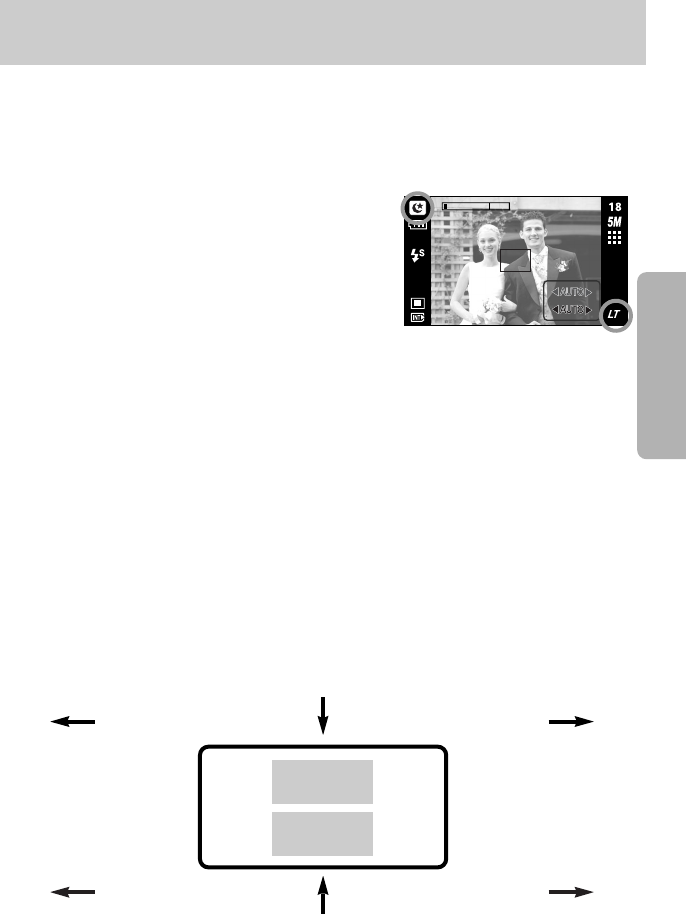
ŝ53Ş
+/- button
ƈLong Time shutter : This camera automatically adjusts the shutter speed and aperture values
to the shooting environment. However, in NIGHT SCENE mode, you can
set the shutter speed and aperture values to your preference.
ƃAdjusting the shutter speed and aperture values
1. Select the [NIGHT] scene mode. (p.24)
2. Press +/- button and Long Time shutter menu
(LT, For selecting shutter speed and aperture value)
will be displayed.
3. Configure the Long Time shutter value with the up/
down/ left/ right button.
Up/ Down Button : Select the Aperture/ Shutter speed
Left/ Right Button : Change the value. Available
aperture value options, depending on zoom step will be displayed on
the menu.
4. Press the +/- button again. The value you set will be saved and the mode will switch to
NIGHT SCENE mode. Press the SHUTTER button to take the picture.
Aperture Value
Shutter Speed
Large/Small
(Press right button)
Large/Small
(Press left button)
Fast/Slow
(Press left button)
Fast/Slow
(Press right button)
ƈAperture values and shutter speeds changed by zoom scale are listed below.
F 3.3
1 S
Supported Aperture Values
: AUTO, WIDE : F3.3 ~ F5.4, TELE : F4.8 ~ F9.3
Supported Shutter Speeds
: AUTO, 1 ~ 16S
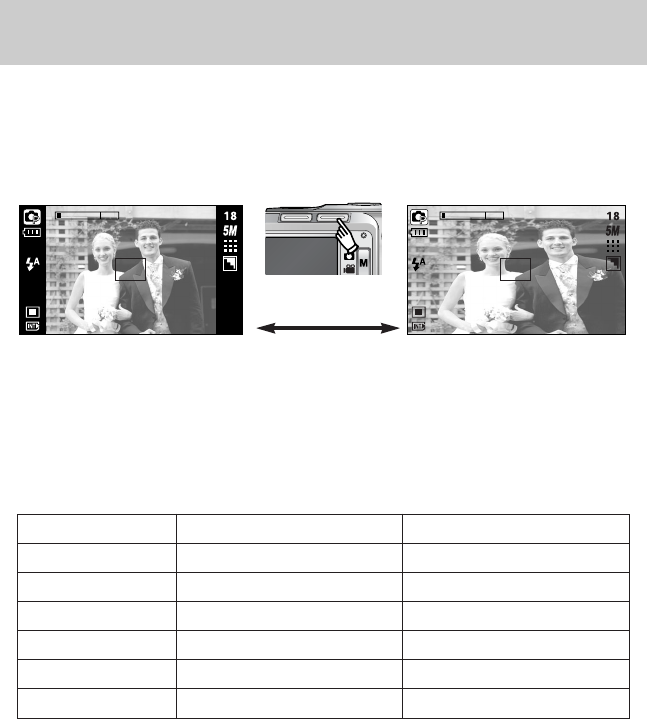
ŝ54Ş
Wide button
ƈYou can select the wide angle mode or normal angle mode by using this button. When you
select the wide angle mode the LCD monitor size will change from 4:3 to 16:9 screen size.
ſWhen you select the wide angle mode, sub menus of [SIZE] menu are changed. For detail
sub menu, refer to below table.
;QbM 6WZUITIVOTMUWLM ?QLMIVOTMUWLM
5M 2592Ŧ1944 2944Ŧ1656
4M 2272Ŧ1704 2688Ŧ1512
3M 2048Ŧ1536 2304Ŧ1296
2M 1600Ŧ1200 1792Ŧ1008
1M 1024Ŧ768 1280Ŧ720
VGA 640Ŧ480 768Ŧ432
8ZM[[QVO\PM?QLMJ]\\WV
[Normal angle mode] [Wide angle mode]
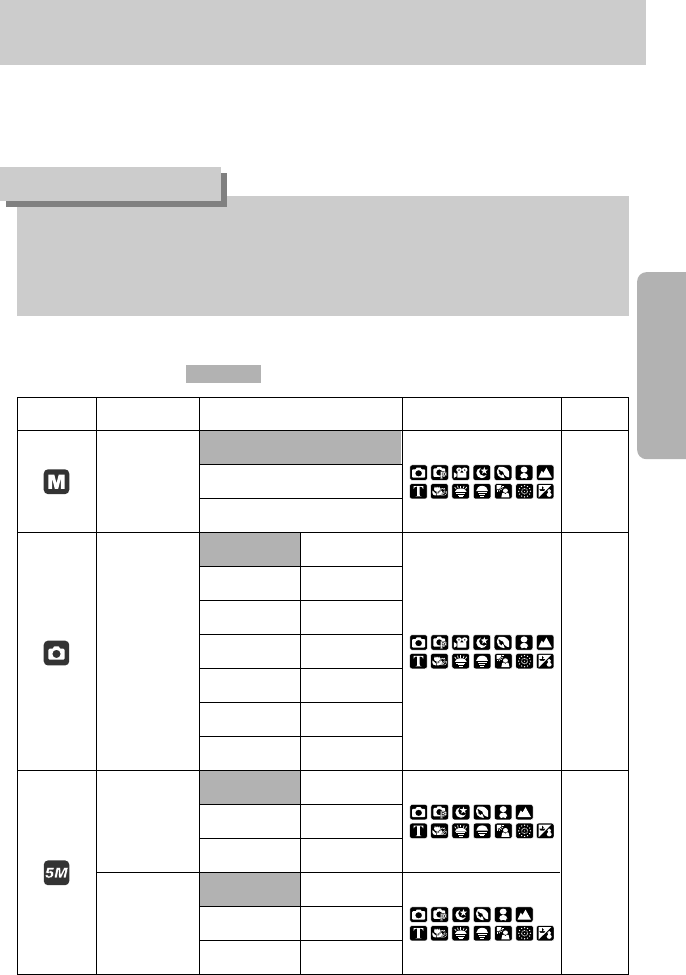
ŝ55Ş
Using the LCD monitor to adjust the camera settings
ƈYou can use the menu on the LCD monitor to set up recording functions. In any mode with
the exception of VOICE RECORDING mode, pressing the MENU button displays the menu
on the LCD monitor.
ƈThe following functions are available, depending on the mode you have selected.
The items indicated by are default settings.
ƃThe menu will not be displayed on the LCD monitor in the following circumstances:
- When another button is being operated.
- While image data is being processed.
- When there is no battery capacity.
INFORMATION
Menu tab Main menu Sub menu Camera working mode Page
STILL&MOVIE
FULL
CUSTOM
AUTO PROGRAM
MOVIE NIGHT
PORTRAIT CHILDREN
MODE SET LANDSCAPE TEXT p.58
CLOSE UP DAWN
SUNSET BACKLIGHT
FIREWORKS
BEACH&SNOW
2592X1944 2272X1704
2048X1536 1600X1200
1024X768 640X480
2944X1656 2688X1512
2304X1296 1792X1008
1280X720 768X432
MODE p.57
p.59
SIZE
(Still image)
(Normal angle)
SIZE
(Still image)
(Wide angle)
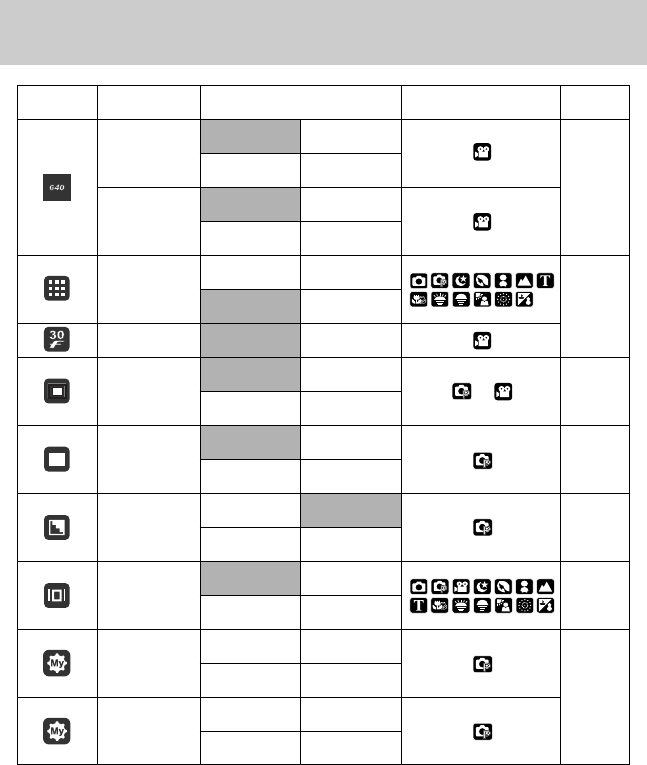
ŝ56Ş
Using the LCD monitor to adjust the camera settings
ſMenus are subject to change without prior notice.
ſThe TIFF file format can't be selected in the Auto mode.
Menu tab Main menu Sub menu Camera working mode Page
640X480 320X240
160X120 -
640X360 384X216
256X144
TIFF SUPER FINE
FINE NORMAL
FRAME RATE 30 FPS 15 FPS
MULTI
CENTER-WEIGHTED
SPOT -
SINGLE
CONTINUOUS
AEB -
SOFT NORMAL
VIVID -
FULL OSD BASIC OSD
SAVE MODE -
MYSET1 MYSET2
MYSET3 -
MYSET1 MYSET2
MYSET3 -
p.59
p.60
p.63
p.61
p.61
p.62
p.62
QUALITY
SIZE
(Movie clip)
(Normal angle mode)
SIZE
(Movie clip)
(Wide angle mode)
SAVE
(MYSET)
LOAD
(MYSET)
METERING
SHOOTING
SHARPNESS
OSD
INFORMATION
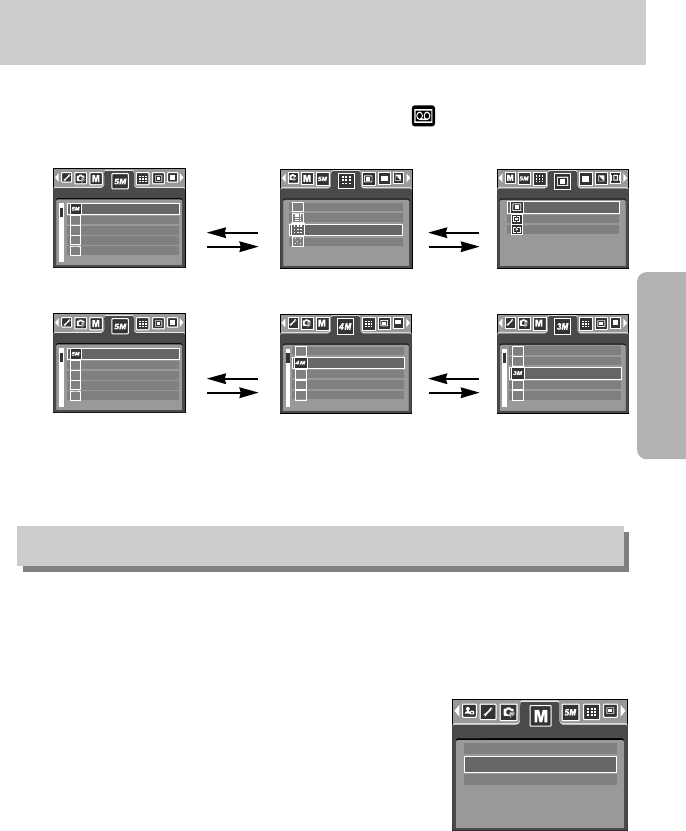
ŝ57Ş
How to use the menu
3. Use the UP and DOWN buttons to select a sub menu.
4. Select a sub menu, and then the value you set will be saved. Press the MENU button and
the menu will disappear.
ƈYou can select the desired working mode by the M (Mode) button located on the back of the
camera and [MODE] menu. Auto, Program, Movie clip, Scene (Night, Portrait, Children,
Landscape, Text, Close-up, Dawn, Sunset, Backlight, Fireworks, Beach & Snow) camera
modes are available.
- [STILL & MOVIE] : A still image mode that was selected on
the [MODE SET] menu and movie clip
mode can be selected.
- [FULL] : Auto, Program, Movie clip and Scene
modes can be selected.
- [CUSTOM] : You can select modes set as on in the
[MODE SET] menu
1. Turn on the camera and press the MENU button. A menu for each camera mode appears.
However, there is no menu for Voice Recording mode ( ).
2. Use the LEFT and RIGHT buttons to navigate through the menus.
Press the LEFT
or RIGHT button.
Press the LEFT
or RIGHT button.
Mode
Press the UP or
DOWN button.
Press the UP or
DOWN button.
MULTI
CENTER-WEIGHTED
SPOT
METERING
TIFF
SUPER FINE
FINE
NORMAL
QUALITY
2592X1944
2272X1704
2048X1536
1600X1200
1024X768
SIZE
5
5
5
5
2592X1944
2272X1704
2048X1536
1600X1200
1024X768
SIZE
5
5
5
5
STILL & MOVIE
FULL
CUSTOM
MODE
SIZE
2592X1944
2272X1704
2048X1536
1600X1200
1024X768
5
5
5
5
SIZE
2592X1944
2272X1704
2048X1536
1600X1200
1024X768
5
5
5
5
<1..
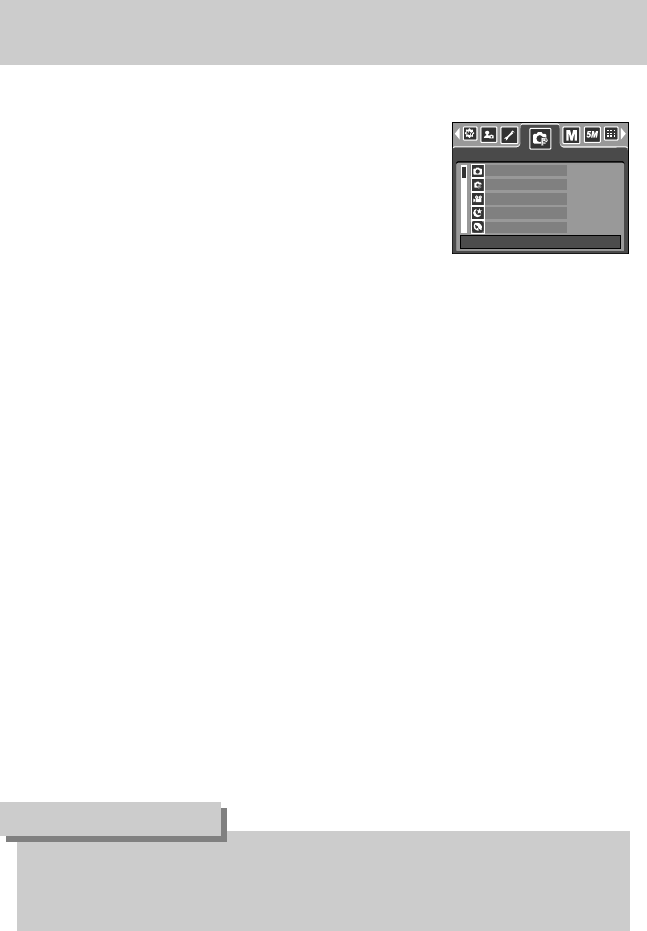
ŝ58Ş
Mode set
ƈYou can select the desired recording mode.
ƈIf you select the [CUSTOM] sub menu in the
[MODE] menu, you can select modes set as on in this menu
by pressing the M button.
- The maximum custom modes you can select are 7 and the
minimum custom modes are 3.
- If you select over 7 custom modes, the menus are set as
off automatically from the lower placed sub menu.
[AUTO] : For shooting basic still image
[PROGRAM] : You can manually configure all functions.
[MOVIE] : For taking a movie clip
[NIGHT] : Use this for shooting still images at night or in other dark conditions.
[PORTRAIT] : To take a picture of a person.
[CHILDREN] : To take a still picture of moving children.
[LANDSCAPE] : Scenery with green woods or blue sky.
[TEXT] : Use this mode to shoot a document.
[CLOSE UP] : Close-up shooting for small objects such as plants and insects.
[DAWN] : Daybreak scenes.
[SUNSET] : For taking pictures of sunsets.
[BACKLIGHT] : Portrait without shadows caused by backlight.
[FIREWORKS] : Firework scenes.
[
BEACH&SNOW
]: For ocean, lake, beach and snowscape scenes.
ƃWhen [NIGHT], [LANDSCAPE], [CLOSE UP], [TEXT], [SUNSET], [DAWN] and
[FIREWORKS] scene mode are selected, it is possible that camera shake will occur. In
this case, you should use a tripod.
INFORMATION
ON
ON
ON
ON
ON
AUTO
PROGRAM
MOVIE
NIGHT
PORTRAIT
MODE SET
EXIT:MENU MOVE:
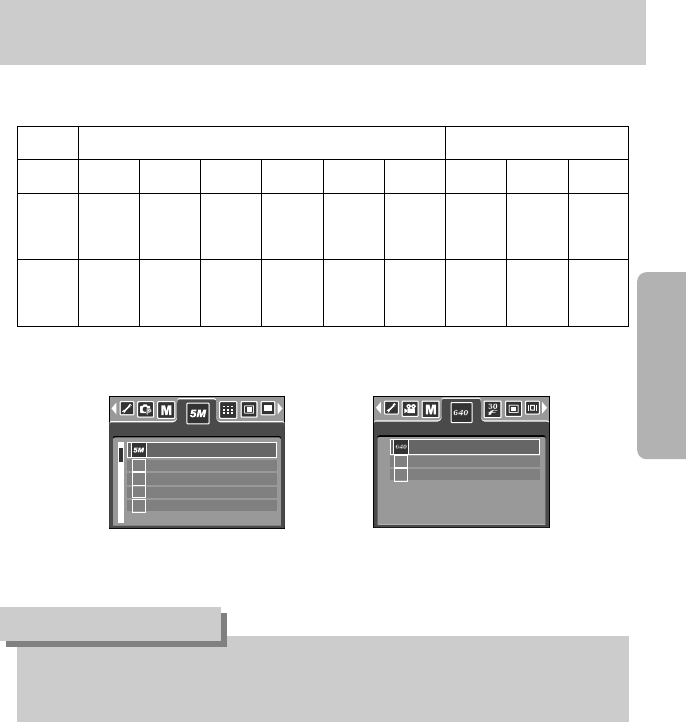
ŝ59Ş
Size
ƈYou can select the image size appropriate for your application.
1KWV 5M 4M 3M 2M 1M VGA 640 320 120
2592X 2272X 2048X 1600X 1024X 640X 640X 320X 160X
1944 1704 1536 1200 768 480 480 240 120
2944X 2688X 2304X 1792X 1280X 768X 640X 384X 256X
1656 1512 1296 1008 720 432 360 216 144
Still image modeMode
Size
(Normal angle)
Size
(Wide angle)
Movie clip mode
ƃThe higher the resolution, the lower the number of available shots will be because high
resolution images require more memory than lower resolution images.
INFORMATION
[ MOVIE CLIP mode ][ STILL IMAGE mode ]
640 X 480
320 X 240
160 X 120
SIZE
SIZE
2592X1944
2272X1704
2048X1536
1600X1200
1024X768
5
5
5
5
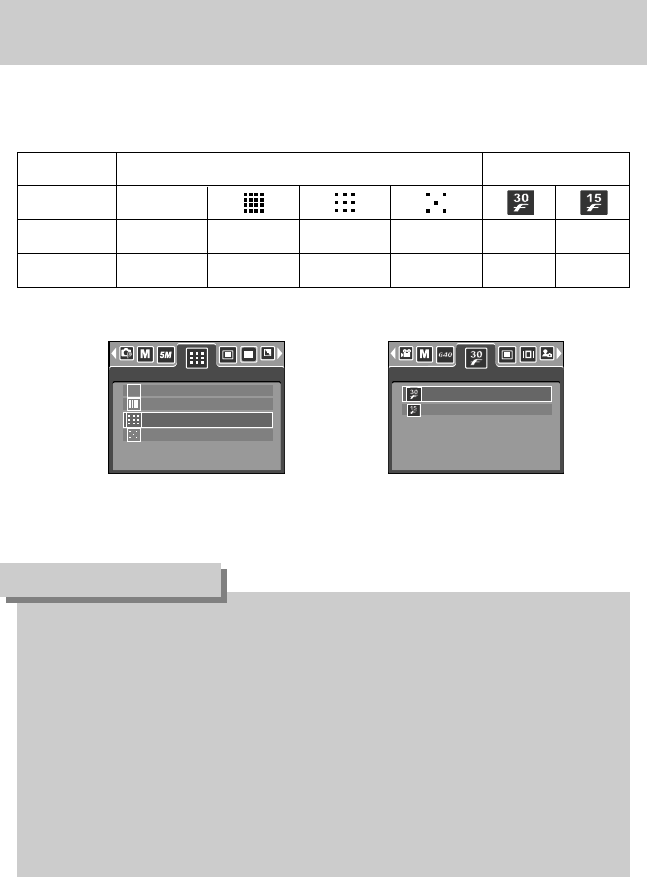
ŝ60Ş
Quality / Frame rate
ƈYou can select the compression ratio appropriate for your application of the captured images.
The higher the compression ratio, the lower the picture quality.
Mode
Icon TIFF
Sub menu TIFF
SUPER FINE
FINE NORMAL 30FPS 15FPS
File Format tif jpeg jpeg jpeg mp4 mp4
STILL IMAGE mode MOVIE CLIP mode
ƃThe TIFF file can’t be rotated, resized and trimmed.
ƃThe TIFF file format is for professionals and provides the best quality.
However, large file size reduces number of available pictures to take and increases
saving time to the memory card.
ƃ[PROCESSING!] message is displayed while saving a TIFF file to the memory card.
ƃThe TIFF file format can't be selected in the Auto mode.
ƃThis file format complies with the DCF (Design rule for Camera File system).
ƃJPEG (Joint Photographic Experts Group): JPEG is the image compression standard
developed by the Joint Photographic Experts Group. This type of compression is most
commonly used for compressing photos and graphics because it can compress the files
efficiently without damaging the data.
INFORMATION
[STILL IMAGE mode] [MOVIE CLIP mode]
30 FPS
15 FPS
FRAME RATEQUALITY
TIFF
SUPER FINE
FINE
NORMAL
<1..